| |
 |
 |
| |
|
Barbados |
| |
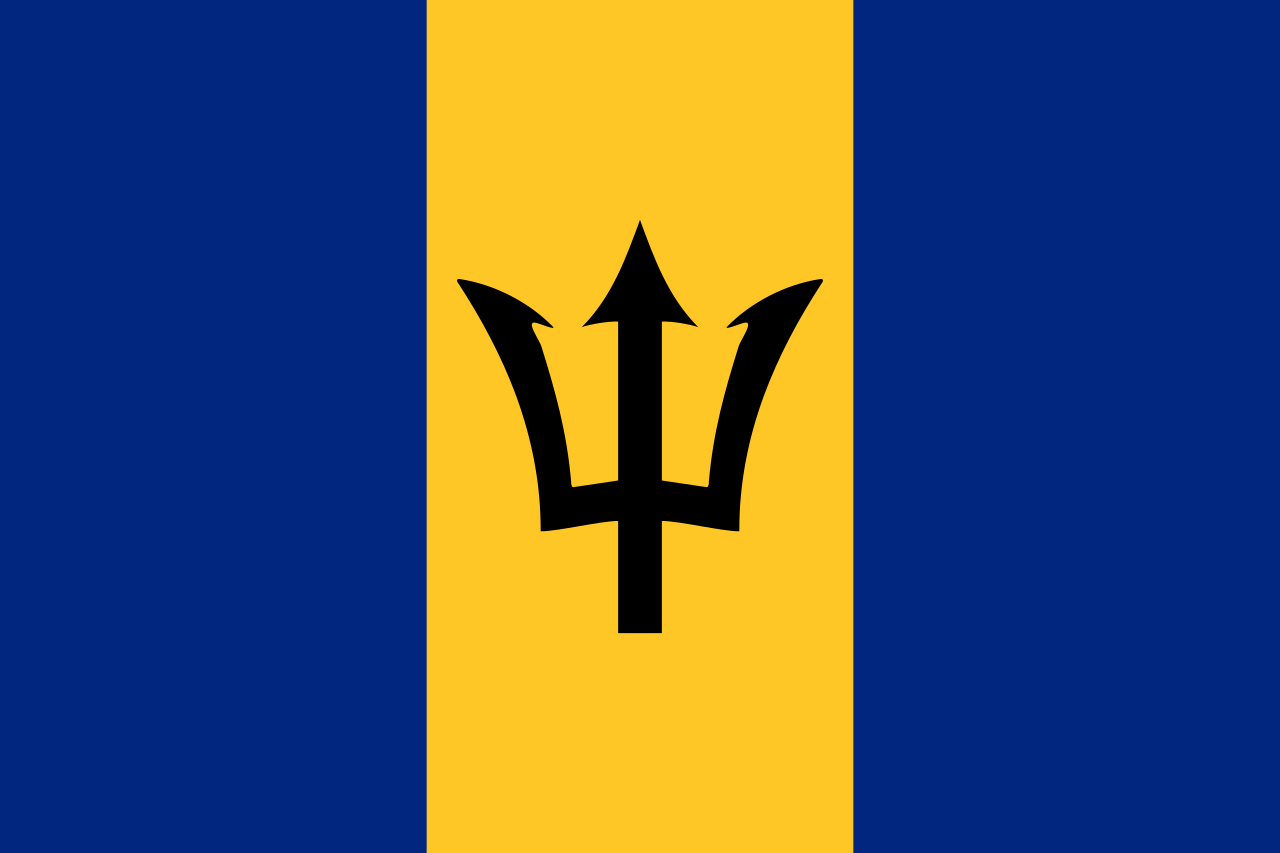 |
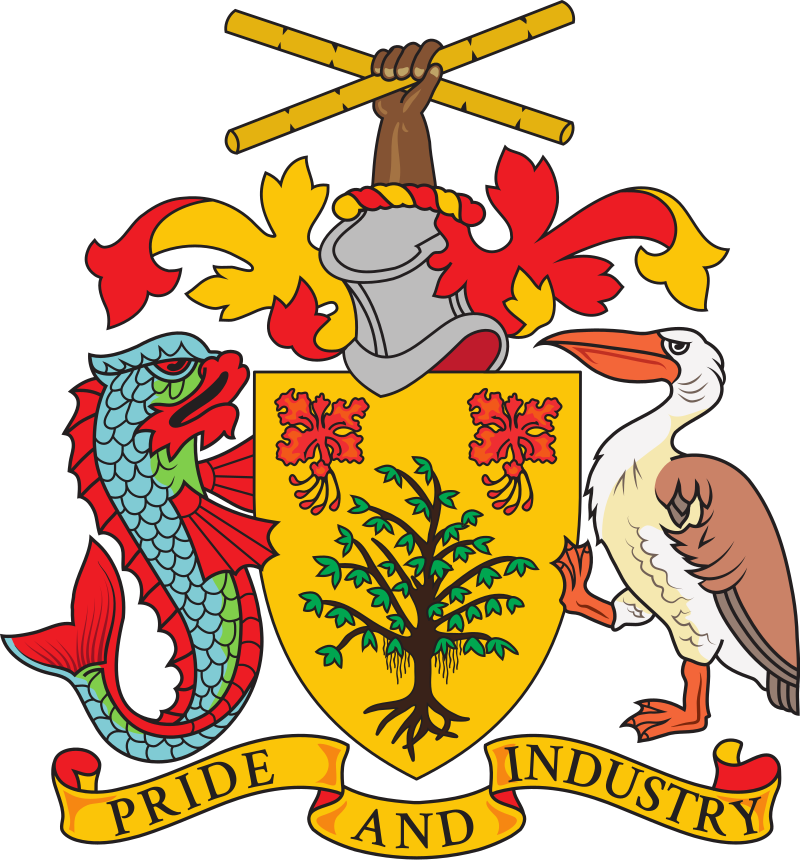 |
| |
Barbados is an
island country in the Lesser Antilles of the West Indies, in the Caribbean
region of North America. It is 34 kilometres (21 miles) in length and up to
23 km (14 mi) in width, covering an area of 432 km2 (167 sq mi). It is
situated in the western area of the North Atlantic and 100 km (62 mi) east
of the Windward Islands and the Caribbean Sea; therein, Barbados is east of
the Windwards, part of the Lesser Antilles, roughly at 13°N of the equator.
It is about 168 km (104 mi) east of both the countries of Saint Lucia and
Saint Vincent and the Grenadines and 180 km (110 mi) south-east of
Martinique and 400 km (250 mi) north-east of Trinidad and Tobago. Barbados
is outside the principal Atlantic hurricane belt. Its capital and largest
city is Bridgetown.
Inhabited by Kalinago people since the 13th century, and prior to that by
other Amerindians, Barbados was visited by Spanish navigators in the late
15th century and claimed for the Spanish Crown. It first appeared in a
Spanish map in 1511. The Portuguese Empire claimed the island between 1532
and 1536, but later abandoned it in 1620; with their only remnants being an
introduction of wild boars for a good supply of meat whenever the island was
visited, and to replenish their supply of freshwater. An English ship, the
Olive Blossom, arrived in Barbados on 14 May 1625; its men took possession
of it in the name of King James I. In 1627, the first permanent settlers
arrived from England, and it became an English and later British colony. As
a wealthy sugar colony, it became an English centre of the African slave
trade until that trade was outlawed in 1807, with final emancipation of
slaves in Barbados occurring over a period of years from 1833.
On 30 November 1966, Barbados became an independent state and Commonwealth
realm with Elizabeth II as its queen. It has a population of people,
predominantly of African descent. Despite being classified as an Atlantic
island, Barbados is considered to be a part of the Caribbean, where it is
ranked as a leading tourist destination. Of the tourists, 40% come from the
UK, with the US and Canada making up the next large groups of visitors to
the island. |
| Capital:
Bridgetown (Jamestown: 1625-1628; Indian Bridge: 1628-c.1660; St. Michael's:
c.1660-19th cent.). Motto: "Pride and
Industry". Population: 293,131 (2018). |
| Territorial
Disputes: Barbados and Trinidad and Tobago abide by the Apr 2006
Permanent Court of Arbitration decision delimiting a maritime boundary and
limiting catches of flying fish in Trinidad and Tobago's exclusive economic
zone; joins other Caribbean states to counter Venezuela's claim that Aves
Island sustains human habitation, a criterion under the UN Convention on the
Law of the Sea (UNCLOS), which permits Venezuela to extend its EEZ/continental
shelf over a large portion of the eastern Caribbean Sea. |
| |
| |
| Chronology:
|
| |
1500s Sighted by the Spanish and the Portuguese and named
Isla de los Barbados or Ilha Barbados.
c.1536 Appears on a French royal map named Bernados.
1542 Appears in a portulano of Jonn Rotz as Barbudoss
and Isla de Beruados.
Jul 1605 Reportedly claimed for England by Capt. Cataline
aboard the "Olive Blossom" (Oliph Blossome)
(not settled), named Barbados.
14 May 1625 Barbados (Barbadoes) claimed for England by Capt. John
Powell working for Sir William Courteen.
1627 English colony (under proprietary rule 1627-1652,
1660-1661).
02 Jul 1627 Granted to James, Earl of Carlisle by King Charles I
of England (as part of the Islands of Carlisle Province).
29 Apr 1650 - 17 Jan 1652 Loyal to Royalist forces of King Charles
II.
13 Jun 1663 Crown colony
01 Apr 1833 - 01 Jun 1885 Part of the Windward Islands (with the
governors of Barbados
as governors of the Windward Islands) [under Grenada].
Nov 1946 Granted semi-responsible government.
03 Jan 1958 - 31 May 1962 Part of the Federation of the West Indies
(under Trinidad and Tobago).
01 Feb 1954 Self rule granted.
30 Nov 1966 Independence from Britain (Barbados).
Text of National Anthem "In Plenty and In Time of Need".
Constitution. |
| |
| |
|
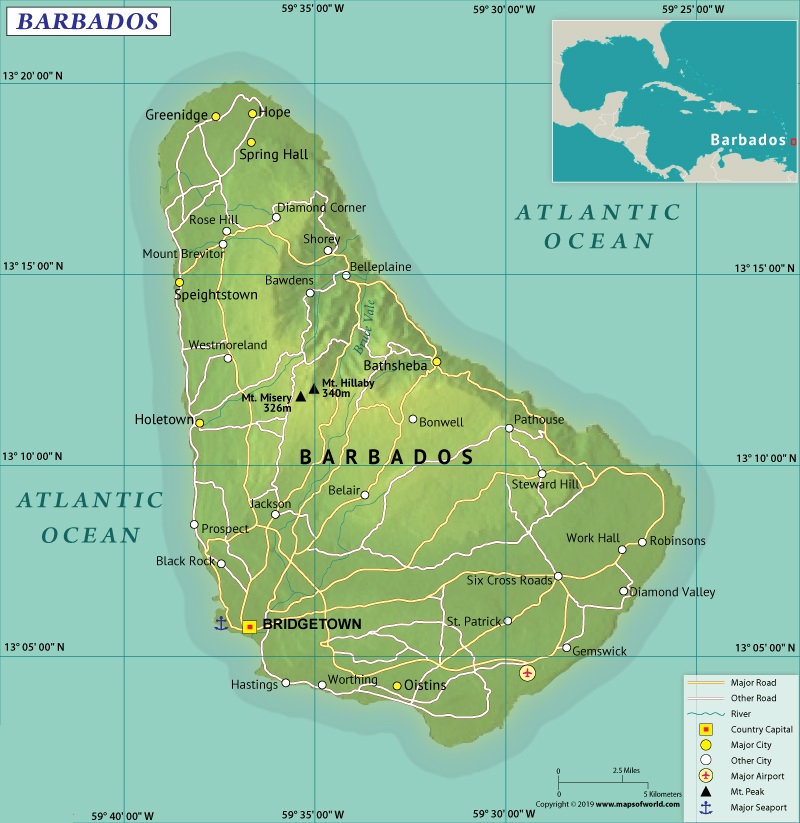 |
|
|
|
|
|
BARBADOS |
- An island in the southeastern Caribbean,
adjacent to but not a part of the Windward Islands archipelago. Its
relative isolation in regards to access via trade winds has given it a
more stable history as a British possession than other Caribbean
islands.
- Great
Britain.............................................1627 - 30 Nov 1966
- Lord
Proprietors
- Sir William
Courteen...............................14 May 1625 - 02 Jul 1627 d. 1636
- He continues in opposition to 21 Dec 1629. Sir
William Courten was the son of William Courten, by his wife Margaret
Casiere, and was born in London in 1572. He was a wealthy 17th century
merchant, operating from London. He financed the colonisation of
Barbados, but lost his investment and interest in the islands to the 1st
Earl of Carlisle.
- James Hay, 1st
Earl of Carlisle....................02 Jul 1627 - 25 Apr 1636 d. 1636
- Hay by 1612 was a director of the Virginia
Company. He was a patentee and councillor of the plantation of New
England, and showed great interest in the colonies. Carlise also had an
interest in the Caribbean. There James Ley, 1st Earl of Marlborough was
a rival, who had to be bought off. Another rival was the Earl of
Montgomery. On 02 July 1627 Carlisle obtained from the king a grant of
all the Caribbean Islands, including Barbados, this being a confirmation
of a former concession given by James I. A colonial plantation venture
on Barbados was led in 1628 by Marmaduke Roydon, a prominent City of
London merchant and one of Carlisle's major creditors. Hay's first wife
was Honoria Denny (only daughter and heir of Edward Denny, 1st Earl of
Norwich). His second wife, Lucy Hay, Countess of Carlisle, was involved
in many conspiracies, or allegations thereof, during the English Civil
War (1642–1651). The first earl died in March 1636 and was succeeded by
James, his only surviving son by his first wife.
- Philip Herbert,
Earl of Pembroke (in
dispute)......25
Feb 1628 - 03 Feb 1629 d. 1649
- Philip Herbert, 4th Earl of Pembroke and 1st
Earl of Montgomery, KG KB (10 October 1584 – 23 January 1650) was an
English courtier, nobleman, and politician active during the reigns of
James I and Charles I. He was born at Wilton House and was the son of
Henry Herbert, 2nd Earl of Pembroke, and his third wife, Mary Sidney,
sister of Sir Philip Sidney the poet, after whom he was named. Born at
Wilton House, he was the son of Henry Herbert, 2nd Earl of Pembroke, and
his third wife, Mary Sidney, sister of Sir Philip Sidney the poet, after
whom he was named. With the coming of the First English Civil War,
Pembroke sided with the parliamentarians. However, Pembroke was always
one of the most moderate parliamentarians. Pembroke represented
Parliament during the negotiations with the king at Oxford in January
1643, and was present during the Treaty of Uxbridge in 1645. As a
supporter of the godly cause, Pembroke was appointed to the Westminster
Assembly in 1643 as a lay assessor. In May 1649, Pembroke fell ill and
spent the rest of 1649 bedridden. He died in his chambers in Whitehall,
Westminster on 23 January 1650.
- Sir James Hay, 2nd
Earl of Carlisle (1st
time).....25
Apr 1636 - 03 Oct 1650 d. 1660
- He was in opposition to 17 Jan 1652. In 1632,
he married Margaret Russell, third daughter of Francis Russell, 4th Earl
of Bedford. In 1639 he inherited the Carlisle Islands, later called
Barbados. Between 1642 and 1646 he was a Royalist Colonel of a Regiment
of Horse. He lived mainly in Barbados but returned in 1652. He died
without issue on 30 October 1660. At his death, the peerage became
extinct in the Hay family.
- Sir James Hay, 2nd
Earl of Carlisle (2nd
time).....08
May 1660 - 30 Oct 1660
- William Hay, 4th
Earl of Kinnoull..................09 Jul 1660 - 28 Mar 1661 d. 1677
- He was a Scottish peer and soldier, loyal to
King Charles I. He escaped not once but twice from Edinburgh Castle. He
inherited the earldom after his older brother died without issue in late
1649 or early 1650. Charles Gordon, 1st Earl of Aboyne writes that
Kinnoull accompanied Montrose after his defeat at the Battle of
Carbisdale in April 1650, when he was ultimately captured. Gordon writes
that Kinnoull "being faint for lack of meat, and not able to go any
further, was left there among the mountains, where it was supposed he
perished." Kinnoull in fact escaped death and continued to fight
Montrose's cause after the latter's execution in May 1650. In December
1653, he was captured near Glamis and taken prisoner in Edinburgh
Castle. Along with some others, the earl succeeded in escaping in May
1654.
He joined forces with James Graham, 2nd Marquess of Montrose, being with
him in battle at the Wood of Methven in June 1654. On 23 November,
Kinnoull was again captured and taken prisoner in Edinburgh Castle, from
which he again escaped. Upon the death of his cousin James Hay, 2nd Earl
of Carlisle in 1660, Kinnoull succeeded him in the proprietorship of
Barbados, but sold it to the Crown in 1661 for a pension.
He married first Lady Mary Brudenell, daughter of Robert Brudenell, 2nd
Earl of Cardigan. She was born 07 January 1636, in Northampton, and died
in 1665. He married secondly, Lady Catherine Cecil, daughter of Charles
Cecil, Viscount Cranborne. They had two sons, both of whom succeeded in
the earldom: George Hay, 5th Earl of Kinnoull (d. 1687) and William Hay,
6th Earl of Kinnoull (d. 10 May 1709). William Hay, 4th Earl of Kinnoull
died on 28 March 1677 and was buried in May in Waltham Abbey Church,
Essex.
|
- Governors
of Barbados
- John Powell (1st
time).............................14
May 1625 - 1625 d. 1629
- Barbados (Barbadoes) claimed for England by
Capt. John Powell working for Sir William Courteen.
- William
Deane.............................................1625 - Jul 1628
- Charles Wolverston
(Wolferstone)...................05 Jul 1628 - 26 Feb 1629
- John
Powell...........................................Jul 1628 - 14 Sep 1628
- He was in opposition, prisoner of Wolverston:
14 Sep 1628 - Jan 1629.
- John Powell (2nd
time).............................14
Jan 1629 - 09 Apr 1629
- Henry Hawley (1st
time)............................09
Apr 1629 - 1629 d. c.1667/69
- Robert Wheatley (acting)...........................29
Aug 1629 - Sep 1629
- Sir William Tufton.................................21
Dec 1629 - Jun 1630 d. 1631
- Henry Hawley (2nd
time)...............................Jun
1630 - 1633
- Richard Peers (1st
time - acting).........................1633
- 1634
- Henry Hawley (3rd
time)............................16
Apr 1634 - 1634
- Richard Peers (2nd
time - acting).........................1634
- Jul 1636
- Henry Hawley (4th
time)...............................Jul
1636 - 1638
- William Hawley (acting)...................................1638
- 1639
- Henry Hawley (5th
time)...................................1639
- 23 Jun 1640
- Sir Henry Hunks (Huncks)...........................23
Jun 1640 - 18 Jun 1641
- Philip Bell (acting
to 1645).......................18
Jun 1641 - 29 Apr 1650
- Francis, Baron
Willoughby of Parham (1st
time).....29
Apr 1650 - 17 Jan 1652 d. 1666
- He became royalist in dissidence from 10 Oct
1651.
- Sir George Ayscue..................................10
Oct 1651 - 29 Mar 1652 d. 1671
- Daniel Searle (Searl)..............................19
Mar 1652 - 16 Jul 1660 d. c. 1680
- Thomas Modyford (Modiford)
(acting)................16
Jul 1660 - 1660 d. 1679
- Humphrey Walrond (acting).................................1660
- Aug 1663 d. c.1670
- Captain
Generals and Governors-in-chief
- Francis, Baron
Willoughby of Parham (2nd
time)........Aug
1663 - 28 Jul 1666
-
Commissioners (joint rulers)
- Henry
Willoughby...................................28 Jul 1666 - 03 Jun 1667
d. 1669
- Henry Hawley (6th
time)............................28
Jul 1666 - 03 Jun 1667
- Samuel Barwick (acting)............................28
Jul 1666 - 03 Jun 1667 d. 1673
- Captain
Generals and Governors-in-chief
- William, Baron of
Willoughby (1st
time)............03
Jun 1667 - Nov 1668 d. 1674
- Christopher
Codrington (1st
time - acting)............Nov
1668 - Dec 1669 d. 1698
- William, Baron of
Willoughby (2nd
time)...............Dec
1669 - 1670
- Christopher
Codrington (2nd
time - acting)................1670
- 02 Jul 1672
- William, Baron of
Willoughby (3rd
time)............02
Jul 1672 - 10 Apr 1673
- Sir Peter Colleton
(acting)........................10
Apr 1673 - 01 Nov 1674 d. 1694
- Sir Jonathan
Atkins................................01 Nov 1674 - Apr 1680 d. 1703
- Sir Richard Dutton
(1st time).........................Apr
1680 - 1683 d. 1703
- Sir John Witham (acting)..................................1683
- Sep 1684 d. 1689
- Sir Richard Dutton
(2nd time).........................Sep
1684 - 1685
- Edwin Stede (1st
time - acting)...........................1685
- 12 May 1690 d. 1695
- James Kendall
(Kendal).............................12 May 1690 - 1694 d. 1708
- Edwin Stede (2nd
time - acting)...........................1694
- 17 Aug 1694
- Francis Russell (Russel)...........................17
Aug 1694 - 07 Aug 1696 d. 1696
- Francis Bond (acting)..............................07
Aug 1696 - 03 Sep 1698
- Ralph
Grey.........................................03 Sep 1698 - 20 Nov 1701
d. 1706
- From Jun 1701, he became known as Ralph, Baron
Grey of Werke.
- John Farmer (acting)...............................20
Nov 1701 - 10 May 1703
- Sir Bevil
Granville (Grenville)....................10 May 1703 - 14 Sep 1706 d.
1706
- William Sharpe (1st
time - acting).................14
Sep 1706 - 09 May 1707
- Mitford Crowe
(Crow)...............................09 May 1707 - 10 May 1710 d. 1719
- George Lillington
(acting).........................10
May 1710 - 22 Jun 1711
- Robert Lowther (1st
time)..........................22
Jun 1711 - 24 Apr 1714 d. 1745
- William Sharpe (2nd
time - acting).................24
Apr 1714 - 12 May 1715
- Robert Lowther (2nd
time)..........................12
May 1715 - 13 Jul 1720
- John Frere (acting)................................13
Jul 1720 - spring 1721 d. 1721
- Samuel Cox (acting)................................spring
1721 - 19 Jan 1723 d. 1724
- Richard Ingram,
Viscount of Irwin..................10 Mar 1721 - 10 Apr 1721 d. 1721
- He did not take office.
- John Hamilton,
Baron of Belhaven...................18 May 1721 - 17 Nov 1721 d. 1721
- He did not take office.
- Henry Worsley......................................19
Jan 1723 - 1727 d. 1740
- Thomas Catesby
Paget......................................1727 - 1731 d. 1742
- James Dotin (1st
time - acting)..................................1731
- Walter Chetwynd...........................................1731
- 1732 d. 1732
- He was from of Grendon, Warwickshire. He was a
British politician who sat in the House of Commons from 1715 to 1731. He
was appointed Governor of Barbados, but died before he took up
residence. As he was preparing to set out for the West Indies, he died
on 05 February 1732.
- Samuel Barwick
(Berwick) Jr. (acting)..............21
Sep 1731 - 01 Jan 1733 d. 1733
- James Dotin (2nd
time - acting)....................01
Jan 1733 - 21 Apr 1733
- Emanuel Scrope
Howe, 2nd Viscount Howe.............21 Apr 1733 - 27 Mar 1735 d. 1735
- He was elected Member of Parliament for
Nottinghamshire in 1722. By 1732 he had encountered financial
difficulties. Duke of Newcastle suggested he resign his seat and take up
the Governorship of the West Indian colony of Barbados which was worth
around £7,000 a year. He accepted the Duke's advice and from 1733 served
as Governor of Barbados until dying there of disease on 29 March 1735.
- James Dotin (3rd
time - acting)....................27
Mar 1735 - 1737
- Orlando Bridgeman.....................................Nov
1737 - 1738 d. 1746
- He did not take office.
- Sir Humphrey
Howorth (Howarth)...................................Aug 1738 d. 1755
- He did not take office.
- Thomas Gage, 1st
Viscount Gage............................1738 - 1739 d. 1754
- In 1738, it was rumoured that he was to be
appointed as Governor of Barbados, but the appointment was never
materialised, probably because he lacked sufficient political
connections.
- Robert Byng........................................15
Dec 1739 - 06 Oct 1740 d. 1740
- In May 1739, he was appointed Governor of
Barbados and resigned his seat in Parliament. Byng died in Barbados on
06 October 1740 and was buried there on the next day.
- James Dotin (3rd
time - acting)....................06
Oct 1740 - 18 Aug 1742
- Sir Thomas
Robinson................................18 Aug 1742 - 14 Apr 1747 d.
1777
- Henry Grenville....................................14
Apr 1747 - 23 May 1753 d. 1784
- Ralph Weeks (Weekes)
(acting)......................23
May 1753 - 10 Aug 1756
- Charles
Pinfold....................................10 Aug 1756 - 27 May 1766 d.
1788
- Samuel Rous (1st
time - acting)....................27
May 1766 - 11 Feb 1768 d. 1784
- William
Spry.......................................11 Feb 1768 - 02 Sep 1772 d.
1772
- On 25 September 1764 he arrived with his
family at Halifax, Nova Scotia, having been appointed judge of the
vice-admiralty court over all America, which had been recently
constituted by act of parliament. In the proclamation that announces the
opening of the court he is styled “The Right Worshipful William Spry,
Doctor of Laws.” The other officers of the new court were: vice-admiral,
the Earl of Northumberland; registrar, the Hon. Spencer Percival;
marshal, Charles Howard, gent. These officers probably expected to
fulfil their duties by deputies. Judge Spry opened his court at Halifax
on 09 October 1764. Its creation had been opposed in the colonies, and
the passage of the Stamp Act the next year, with the accompanying
disturbances, probably prevented its extension to other provinces. The
Court was abolished in 1768. Judge Spry was appointed Governor of
Barbados in June 1767. Spry arrived at Barbados the following year, and
died in office on 04 September 1772.
- Samuel Rous (2nd
time - acting)....................02
Sep 1772 - 08 Jun 1773
- Edward
Hay.........................................08 Jun 1773 - 24 Oct 1779 d.
1779
- Samuel Rous (3rd
time - acting)....................24
Oct 1779 - 26 Oct 1779
- John Dotin (1st
time - acting).....................26
Oct 1779 - 12 Jul 1780
- James Cunninghame
(Cunningham).....................12 Jul 1780 - 19 Jun 1782 d. 1788
- John Dotin (2nd
time - acting).....................19
Jun 1782 - 07 Jan 1783
- David Parry (1st
time).............................07
Jan 1783 - 06 Jul 1790 d. 1793
- Henry Frere (acting)...............................06
Jul 1790 - 24 Jun 1791 d. 1792
- David Parry (2nd
time).............................24
Jun 1791 - 22 Jul 1793
- William Bishop (1st
time - acting).................22
Jul 1793 - Jun 1794 d. 1801
- George Poyntz
Rickets.................................Jun 1794 - Mar 1800 d. 1800
- William Bishop (2nd
time - acting)....................Mar
1800 - 26 Mar 1801
- Francis
Humberstone Mackenzie, 1st Baron Seaforth..26 Mar 1801 - 25 Jul 1806 d.
1815
- John Ince (acting).................................25
Jul 1806 - 31 Jul 1806 d. 1806
- John Spooner (1st
time - acting)...................31
Jul 1806 - 30 Jul 1810 d. 1840
- Sir George
Beckwith................................30 Jul 1810 - 23 Jun 1814 d.
1823
- John Spooner (2nd
time - acting)...................23
Jun 1814 - 10 May 1815
- Sir James Leith....................................10
May 1815 - 16 Oct 1816 d. 1816
- John Spooner (3rd
time - acting)...................21
Oct 1816 - 08 Apr 1817
- John Foster
Alleyne (acting).......................08
Apr 1817 - 04 Jun 1817 d. 1823
- Stapleton Cotton,
1st Viscount Combermere..........04 Jun 1817 - 12 Jun 1820 d. 1865
- John Braithwaite
Skeete (1st
time - acting)........12
Jun 1820 - 18 Apr 1821 d. 1847
- Samuel Hinds (acting)..............................18
Apr 1821 - 26 Jul 1821
- Sir Henry Warde (1st
time).........................26
Jul 1821 - 26 May 1825 d. 1834
- John Braithwaite
Skeete (2nd
time - acting)........26
May 1825 - 25 Aug 1826
- Sir Henry Warde (2nd
time).........................25
Aug 1826 - 21 Jun 1827
- John Braithwaite
Skeete (3rd
time - acting)........21
Jun 1827 - 10 Feb 1829
- Sir James
Lyon.....................................10 Feb 1829 - 21 Jul 1832 d.
1842
- John Braithwaite
Skeete (4th
time - acting)........21
Jul 1832 - 30 Apr 1833
- Governors
(and Commanders-in-chief) of Barbados and the Windward Islands
(1833–1885)
- Sir Lionel
Smith...................................30 Apr 1833 - 20 Aug 1836 d.
1842
- John Alleyne
Beckles (acting)......................20
Aug 1836 - 17 Oct 1836 d. 1840
- Evan John Murray
MacGregor.........................18 Oct 1836 - 14 Jun 1841 d. 1841
- From 19 Jul 1838, he became known as Sir Evan
John Murray MacGregor.
- John Braithwaite
Skeete (5th
time - acting)........14
Jun 1841 - 29 Jun 1841
- Henry Charles
Darling (acting).....................29
Jun 1841 - 22 Feb 1842 d. 1845
- Darling served with the Army in Annapolis
Royal in the Colony of Nova Scotia around 1809. He was a Major General
in the British Army and served as Lieutenant Governor of Tobago
(1833–45). He died on 11 February 1845.
- Sir Charles Edward
Grey............................22 Feb 1842 - 09 Dec 1846 d. 1865
- William
Reid.......................................09 Dec 1846 - Sep 1848 d.
1858
- William Macbean
George Colebrooke..................08 Sep 1848 - Jan 1856 d. 1870
- Grant E. Thomas (acting).........................................Jan
1856
- Francis Hincks (1st
time)..........................25
Jan 1856 - 13 Mar 1859 d. 1885
- James Walker (1st
time - acting)...................13
Mar 1859 - 25 Dec 1859 d. 1885
- Francis Hincks (2nd
time)..........................25
Dec 1859 - 04 Jan 1862
- James Walker (2nd
time)............................25
Mar 1862 - Jan 1869
- Rawson William
Rawson..............................15 Apr 1869 - Jul 1875 d. 1899
- Sanford Freeling (acting).............................Jul
1875 - Nov 1875 d. 1894
- Sir John Pope
Hennessy................................Nov 1875 - 02 Dec 1876 d. 1891
- George Cumine
Strahan..............................20 Dec 1876 - May 1880 d. 1887
- He served as 67th Governor of the Gold Coast
Colony: June 1874 – 07 April 1876 and also 5th Governor of Tasmania: 07
December 1881 – 28 October 1886. Strahan left Tasmania in October 1886,
and returned to England via Melbourne. He was appointed as Governor of
Hong Kong to replace Sir George Bowen, but died in Bournemouth on 17
February 1887 before he could take up the appointment.
- Dominic Jacotin
Gamble (acting).......................May
1880 - Aug 1880 d. 1887
- Major-General Dominic Jacotin Gamble CB (b. 15
August 1823 – d. 21 November 1887) was a British Army officer from 1844
until his death in 1887. He played a significant role in the New Zealand
wars under Lieutenant General Duncan Cameron and the 4th Foot Regiment.
After he was promoted to Major-General (1877) he arrived at Barbados on
01 October 1878 and took command of British forces in the West Indies
and even held the post as Deputy Governor of Barbados and the Windward
Islands during 1880. Returning to England, he was appointed
Director-General of military education in 1887 but unfortunately he died
at South Kensington, London on 21 November 1887.
- William Robinson (1st
time)...........................Aug
1880 - 28 Sep 1881 d. 1912
- Sir Robert W.
Harley (acting)......................28
Sep 1881 - Jan 1882 d. 1892
- William Robinson (2nd
time)...........................Jan
1882 - 1885
- Governors
of Barbados
- Sir Charles
Cameron Lees...........................09 Oct 1885 - Nov 1889 d. 1898
- Sir Walter Joseph
Sendall.............................Nov 1889 - 1891 d. 1904
- Sir James Shaw Hay
(1st time)......................24
Nov 1891 - Aug 1895 d. 1924
- He was acting to 1892.
- George Ruthven Le
Hunte (1st time
- acting)...........Aug
1895 - Dec 1895 d. 1925
- Sir James Shaw Hay
(2nd time).........................Dec
1895 - May 1897
- George Ruthven Le
Hunte (2nd time
- acting)...........May
1897 - Jul 1897
- Sir James Shaw Hay
(3rd time).........................Jul
1897 - Oct 1898
- Ralph Champneys
Williams (1st
time - acting)..........Oct
1898 - Dec 1898 d. 1927
- Sir James Shaw Hay
(4th time).........................Dec
1898 - Dec 1900
- Ralph Champneys
Williams (2nd
time - acting)..........Dec
1900 - Feb 1901
- Sir Frederick
Mitchell Hodgson (1st
time)..........18
Feb 1900 - 1903 d. 1925
- Samuel William
Knaggs (1st
time - acting)........................1903
d. 1924
- Sir Frederick
Mitchell Hodgson (2nd
time).................1903
- 1904
- Samuel William
Knaggs (2nd
time - acting).................1904
- 24 Oct 1904
- Sir Gilbert Thomas
Carter..........................24 Oct 1904 - Jul 1910 d. 1927
- John Alder Burdon
(acting)............................Jul
1910 - 13 Feb 1911 d. 1933
- Sir Leslie Probyn..................................13
Feb 1911 - 1918 d. 1938
- Thomas Edward Fell
(acting)...........................May
1918 - Sep 1918 d. 1926
- Charles Richard
Mackey O'Brien.....................27 Sep 1918 - May 1922 d. 1935
- From 01 Jan 1920, he became known as Sir
Charles Richard Mackey O'Brien.
- Wilfrid Edward
Francis Jackson (1st
time - acting)....May
1922 - Oct 1922 d. 1971
- Sir Charles
Richard Mackey O'Brien (2nd
time).........Oct
1922 - Jun 1922
- Wilfrid Edward
Francis Jackson (2nd
time - acting)....Jun
1924 - Sep 1924
- Sir Charles
Richard Mackey O'Brien (3rd
time).........Sep
1924 - Aug 1925
- Wilfrid Edward
Francis Jackson (3rd
time - acting)....Aug
1925 - 31 Dec 1925
- William Charles
Fleming Robertson..................31 Dec 1925 - Jan 1933 d. 1937
- From Jun 1927, he became known as Sir William
Charles Fleming Robertson.
- Harry Scott
Newlands..................................Jan 1933 - 12 Mar 1933 d. 1933
- George Douglas
Owen (acting).......................12
Mar 1933 - Jul 1933 d. 1965
- Mark Aitchison
Young...............................05 Aug 1933 - 02 Mar 1938 d. 1974
- From 04 Jun 1934, he became known as Sir Mark
Aitchison Young.
- William Henry
Flinn (1st time
- acting)............02
Mar 1938 - 06 Aug 1938 d. 1973
- Eubule John
Waddington.............................06 Aug 1938 - 1941 d. 1957
- From 08 Jun 1939, he became known as Sir
Eubule John Waddington.
- William Henry
Flinn (2nd time
- acting)...................1941
- 23 Oct 1941
- Sir Henry Grattan
Bushe............................23 Oct 1941 - 1947 d. 1961
- Stewart Henry
Perowne (1st
time - acting).................1947
- 08 Feb 1947 d. 1989
- Sir Hilary Rudolph
Robert Blood....................08 Feb 1947 - 15 Mar 1949 d. 1967
- Stewart Henry
Perowne (2nd
time - acting)..........15
Mar 1949 - 01 Nov 1949
- Alfred William
Lungley Savage......................01 Nov 1949 - 05 Nov 1952 d. 1980
- From 01 Jan 1951, he became known as Sir
Alfred William Lungley Savage.
- Robert Noel Turner
(acting)........................05
Nov 1952 - 14 May 1953 d. 1987
- Sir Robert Duncan
Harris Arundell..................14 May 1953 - 07 Jul 1959 d. 1989
- Guy Trayton Barton
(acting)........................07
Jul 1959 - 08 Oct 1959 d. 1977
- Sir John Montague
Stow.............................08 Oct 1959 - 29 Nov 1966 d. 1997
|
- Independent
within the Commonwealth................30 Nov 1966 - date
- Governors
general (representing the British
monarch as head of state)
- Head of the state is
Queen Elizabeth II.
Her title 30 Nov 1966 - 04 May 1967: "By the Grace of God, of the United
Kingdom of Great Britain and Northern Ireland and of Her other Realms
and Territories Queen, Head of the Commonwealth, Defender of the Faith";
from 04 May 1967: "By the Grace of God, Queen of Barbados and of Her
other Realms and Territories, Head of the Commonwealth."
- Sir John Montague
Stow (continued).................30
Nov 1966 - 18 May 1967
- Sir Arleigh
Winston Scott..........................18 May 1967 - 09 Aug 1976 d. 1976
- Sir William
Randolph Douglas (1st
time - acting)...09
Aug 1976 - 17 Nov 1976 d. 2003
- Sir Deighton
Harcourt Lisle Ward...................17 Nov 1976 - 09 Jan 1984 d. 1984
- Sir William
Randolph Douglas (2nd
time - acting)...10
Jan 1984 - 24 Feb 1984
- Sir Hugh Worrell
Springer..........................24 Feb 1984 - 06 Jun 1990 d. 1994
- Dame Ruth Nita
Barrow (female).....................06
Jun 1990 - 19 Dec 1995 d. 1995
- Sir Denys Ambrose
Williams (acting)................19
Dec 1995 - 01 Jun 1996 d. 2014
- Sir Clifford
Straughn Husbands.....................01 Jun 1996 - 02 Nov 2011 d. 2017
- Elliot Fitzroy
Belgrave (1st
time - acting)........02
Nov 2011 - 30 May 2012
- Sandra Prunella
Mason (fem. 1st
time - acting).....30
May 2012 - 01 Jun 2012
- Sir Elliot Fitzroy
Belgrave (2nd
time).............01
Jun 2012 - 30 Jun 2017
- Sir Philip Marlowe
Greaves (acting)................01
Jul 2017 - 08 Jan 2018
- Dame Sandra
Prunella Mason (fem.
2nd time).........08
Jan 2018 - date
|
|
|
| |
| |
|
Coinage |
| |
| Currency: Eastern Caribbean Dollar (XCD)
= 100 cents. [06 October 1965 - 03 December 1973] |
| |
|
1970 |
| |
|
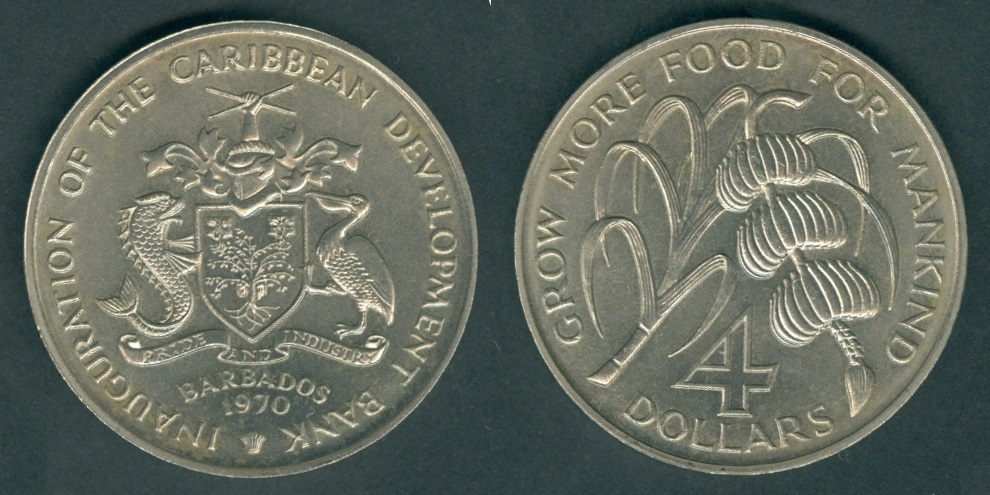 |
|
KM#A9 4
Dollars. Year:
1970. Weight:
28.29 grams. Metal:
Copper-Nickel. Edge:
Reeded. Diameter:
38.00 mm.
Alignment:
Medal. Mint:
British Royal Mint.
Obverse: Barbados Coat and Arms
in the center with Motto: "PRIDE AND INDUSTRY". "INAUGURATION OF THE CARIBBEAN DEVELOPMENT BANK"
written in circular form, near the edge. "BARBADOS" written below
the Coat and Arms with Date "1970" below it.
Reverse:
Sugar cane and Banana tree branches in the center.
"GROW MORE FOOD FOR MANKIND" on the
top section. Value "4 DOLLARS" written at the bottom.
Mintage:
30,000 (including 2,000 proof pieces).
Proofs were made in 1971.
Minted Years: One year
type. Subject: F.A.O. issue. Governor:
Sir Arleigh Winston Scott
(1967 - 1976) under
British monarch:
Elizabeth II [Elizabeth Alexandra Mary Windsor].
Note: A series of 4-dollar coins tied to the FAO coinage program were
released in 1970 under the name of the Caribbean Development Bank by
eight loosely federated island groupings in the eastern Caribbean.
These issues are listed individually under
Antigua,
Barbados,
Dominica,
Grenada,
Montserrat,
Saint Kitts and Nevis,
Saint Lucia and
Saint Vincent. |
|
| |
| |
| Currency:
Barbadian Dollar (BBD) = 100 cents. [03 December 1973 - date] |
The history of currency in the
British colony of Barbados closely follows that of British Eastern Caribbean
territories in general. Even though Queen Anne's proclamation of 1704
brought the gold standard to the West Indies, silver pieces of eight
(Spanish dollars and later Mexican dollars) continued to form a major
portion of the circulating currency right into the latter half of the
nineteenth century.
Britain adopted the gold standard in 1821 and an imperial order-in-council
of 1838 resulted in Barbados formally adopting the British sterling coinage
in the year 1848. However, despite the circulation of British coins in
Barbados the silver pieces of eight continued to circulate alongside them
and the private sector continued to use dollar accounts for reckoning. The
international silver crisis of 1873 signalled the end of the silver dollar
era in the West Indies and silver dollars were demonetized in Barbados in
1879. This left a state of affairs, in which the British coinage circulated,
being reckoned in dollar accounts at an automatic conversion rate of 1
dollar = 4 shillings 2 pence. The first currency denominated in dollars to
be issued in Barbados was in the form of private banknotes introduced in
1882. No subdivisions of the dollar were issued and these notes circulated
alongside sterling, together with 1 pound notes issued by the government in
1917. From 1920, some of the private banknotes also carried a denomination
in sterling, with 1 dollar = 4 shillings 2 pence.
From 1949, with the introduction of the British West Indies dollar, the
currency of Barbados became officially tied with those of the British
Eastern Caribbean territories in general. Between 1938 and 1949, the
Barbados government issued paper money denominated in dollars. The last
private bank issues were made in 1949. The British sterling coinage was
eventually replaced by a new decimal coinage in 1955, with the new cent
being equal to one half of the old penny. On 06 October 1965, the Eastern Caribbean
dollar replaced the British West Indies dollar in Barbados.
The present dollar was created after the establishment of the Central Bank
of Barbados (CBB), which was founded by an Act of parliament in May, 1972.
The Barbados dollar replaced the East Caribbean dollar at par in 1973. Since
05 July 1975, the Barbados dollar has been pegged to the US dollar at US$1 =
Bds$2. Most people in Barbados will accept USD at the fixed rate. Exchanging
money at the airport yields however a lower rate (US$1 = Bds$1.98 + a
service fee when buying Bds). |
| |
|
1973 |
| In 1973, the first year of Barbados
having its own coinage, coins were introduced in denominations of 1¢, 5¢,
10¢, 25¢, and $1. The reverse of the 5 cent coin depicts the South Point
Lighthouse, the oldest lighthouse in Barbados. From 1973 through 1991, the
1¢ was struck in bronze. From 1992, copper-plated zinc has been used. The 5¢
coin is struck in brass, whilst the highest 3 denominations are struck in
cupronickel. The $1 coin is a 7-sided equilaterally-curved piece. A flying
fish is adorned on one side, with the Barbadian coat of arms on the reverse.
The Barbadian dollar coins are now minted in a plated-steel planchet first
issued in 2007. Many of the coins in circulation have been struck at the
Royal Canadian Mint recently. |
| |
|
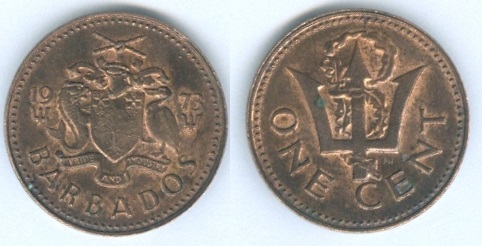 |
KM#10
/ Schön# 2
1
Cent. Year:
1973. Weight:
3.05g [3.10 g]. Metal:
Bronze.
Diameter:
18.50 mm.
Thickness: 1.50 mm.
Edge:
Plain. Alignment:
Medal. Mint:
Royal
Canadian Mint.
Type1:
Heavy type. |
|
Obverse:
Barbados Coat and Arms
with motto on banner "PRIDE AND INDUSTRY" in the center. The first
two digits of Date on left side with small trident below it and last
two digits of Date on the right side with a small trident below it
as well. "BARBADOS" written at the bottom
section.
Reverse:
Large trident with
trailing leaves (The Broken Trident) within it, in the center.
Value "ONE CENT" written at the bottom section.
Mintage:
5,000,000.
Minted Years:
1973 (Royal Canadian Mint), 1973 FM Matte, 1973 FM Proof, 1974
(Royal Canadian Mint), 1974 FM Matte, 1974 FM Proof, 1975 (Royal
Canadian Mint), 1975 FM Matte, 1975 FM Proof, 1975 FM Special
Uncirculated, 1977 FM Matte, 1977 FM Proof, 1977 FM Special
Uncirculated, 1978 (Royal Canadian Mint), 1978 FM Matte, 1978 FM
Proof, 1978 FM Special Uncirculated, 1979 (Royal Canadian Mint),
1979 FM Matte, 1979 FM Proof, 1979 FM Special Uncirculated, 1980
(Royal Canadian Mint), 1980 FM Matte, 1980 FM Proof, 1980 FM Special
Uncirculated, 1981 (Royal Canadian Mint), 1981 FM Matte, 1981 FM
Proof, 1981 FM Special Uncirculated, 1982 (Royal Canadian Mint),
1982 FM Proof, 1982 FM Special Uncirculated, 1983 FM Matte, 1983 FM
Proof, 1983 FM Special Uncirculated, 1984 (Royal Canadian Mint),
1984 FM Matte, 1984 FM Proof, 1985 (Royal Canadian Mint), 1986
(Royal Canadian Mint), 1987 (British Royal Mint), 1988 (British
Royal Mint), 1989 (British Royal Mint), 1990 (British Royal Mint)
and 1991 (British Royal Mint). Engraver:
Philip Nathan (both sides).
FM:
The Franklin Mint, Wawa, Pennsylvania, United States
(1964-date). "FM" mintmark include (M) Matte, (P) Proof, and (U)
Special Uncirculated Issues. FM has a "f" mintmark above D in
BARBADOS.
Note:
Coins dated 1987, 1989, 1990 and 1991, minted by British Royal
mint, have been reported for
both KM#10 (bronze, 3.10 g) and KM#10a (Copper plated zinc, 2.50 g). |
|
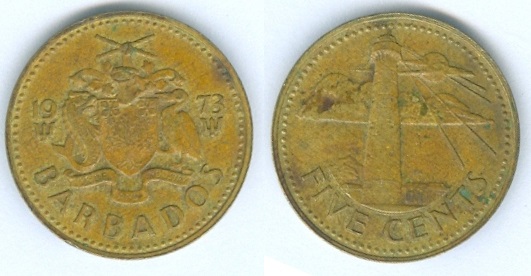 |
KM#11
/ Schön# 3
5
Cents. Year:
1973. Weight:
3.68g [3.75 g]. Metal:
Brass.
Diameter:
21.00 mm.
Thickness: 1.67 mm.
Edge:
Plain. Alignment:
Medal. Mint:
Royal
Canadian Mint.
Type1:
Heavy type and non-magnetic. |
|
Obverse:
Barbados Coat and Arms
with motto on banner "PRIDE AND INDUSTRY" in the center. The first
two digits of Date on left side with small trident below it and last
two digits of Date on the right side with a small trident below it
as well. "BARBADOS" written at the bottom
section.
Reverse:
South Point Lighthouse with four light rays
pointing downwards in the center with it's tower above clouds. Moon
in the clouds at the upper right side. Value "FIVE CENTS" written at the bottom section.
Mintage:
3,000,000.
Minted Years:
1973 (Royal Canadian Mint), 1973 FM Matte, 1973 FM Proof,
1974 (Royal Canadian Mint), 1974 FM Matte, 1974
FM Proof, 1975 FM Matte, 1975 FM Proof, 1975 FM Special Uncirculated,
1977 FM Matte, 1977 FM Proof, 1977 FM Special Uncirculated, 1978 FM Matte, 1978 FM Proof, 1978 FM Special Uncirculated, 1979 (Royal
Canadian Mint), 1979 FM Matte, 1979 FM Proof, 1979
FM Special Uncirculated, 1980 FM Matte, 1980 FM
Proof, 1980 FM Special Uncirculated, 1981 FM
Matte, 1981 FM Proof, 1981 FM Special Uncirculated, 1982 (Royal
Canadian Mint), 1982 FM Proof, 1982 FM Special Uncirculated, 1983 FM Matte,
1983 FM Proof, 1983 FM Special Uncirculated, 1984
FM Matte, 1984 FM Proof, 1985 (Royal Canadian Mint), 1986 (Royal
Canadian Mint), 1988 (Royal Canadian Mint), 1989 (British Royal Mint),
1991 (British Royal Mint), 1994 (Royal Canadian Mint), 1995 (Royal
Canadian Mint), 1996 (Royal Canadian Mint), 1997 (Royal Canadian
Mint), 1998 (Royal Canadian Mint), 1999 (Royal Canadian Mint), 2000
(Royal Canadian Mint), 2001 (Royal Canadian Mint), 2002 (Royal
Canadian Mint), 2004 (Royal Canadian Mint), 2005 (Royal Canadian
Mint), 2006 (Royal Canadian Mint) and 2007 (Royal Canadian Mint).
Engraver:
Philip Nathan (both sides).
South Point Lighthouse is a
lighthouse located in the south of Barbados. Its height is 89 feet
(27 m). It is the oldest lighthouse in Barbados. It was brought to
Barbados in 1852, one year after being shown at London's Great
Exhibition, and reassembled on the southernmost point of the island.
Although still listed as active, the lighthouse is now considered to
be more of a national landmark and tourist attraction, with its
grounds (but not tower) being made open to the public. The
lighthouse has been depicted on the reverse of the 5 cent coin of
the Barbadian coinage since 1973. |
|
 |
Same as above coin but Dark in colour.
Weight: 3.79 g
[3.81g]. |
|
 |
KM#12
/ Schön# 4
10
Cents. Year:
1973. Weight:
2.23g [2.27 g]. Metal:
Copper-Nickel.
Diameter:
17.25 mm.
Thickness: 1.13 mm.
Edge:
Reeded. Alignment:
Medal. Mint:
Royal
Canadian Mint.
Type1:
Heavy type and non-magnetic. |
|
Obverse:
Barbados Coat and Arms
with motto on banner "PRIDE AND INDUSTRY" in the center. The first
two digits of Date on left side with small trident below it and last
two digits of Date on the right side with a small trident below it
as well. "BARBADOS" written at the bottom
section.
Reverse:
Laughing Gull flying
left in the center. Value "TEN CENTS" written at the bottom section.
Mintage:
4,000,000.
Minted Years:
1973 (Royal Canadian Mint), 1973 FM Matte, 1973 FM Proof,
1974 (Royal Canadian Mint), 1974 FM Matte, 1974
FM Proof, 1975 FM Matte, 1975 FM Proof, 1975 FM Special Uncirculated,
1977 FM Matte, 1977 FM Proof, 1977 FM Special Uncirculated, 1978 FM Matte, 1978 FM Proof, 1978 FM Special Uncirculated, 1979 (Royal
Canadian Mint), 1979 FM Matte, 1979 FM Proof, 1979
FM Special Uncirculated, 1980 (Royal Canadian Mint), 1980 FM Matte, 1980 FM
Proof, 1980 FM Special Uncirculated, 1981 FM
Matte, 1981 FM Proof, 1981 FM Special Uncirculated, 1982 FM Matte, 1982 FM Proof, 1982 FM Special Uncirculated, 1983 FM Matte,
1983 FM Proof, 1983 FM Special Uncirculated, 1984 (Royal Canadian
Mint), 1984 FM Proof, 1985 (Royal Canadian Mint), 1986 (Royal
Canadian Mint), 1988 (Royal Canadian Mint), 1989 (British Royal Mint),
1990 (British Royal Mint), 1992 (Royal Canadian Mint), 1995 (Royal
Canadian Mint), 1996 (Royal Canadian Mint), 1997 (Royal Canadian
Mint), 1998 (Royal Canadian Mint), 2000
(Royal Canadian Mint), 2001 (Royal Canadian Mint), 2003 (Royal
Canadian Mint), 2004 (Royal Canadian Mint) and 2005 (Royal Canadian Mint).
Engraver:
Philip Nathan (both sides).
The
Central Bank of
Barbados identifies the bird as a Tern,
but this is incorrect as Terns have a forked tail.
The laughing gull (Leucophaeus atricilla) is a medium-sized
gull of North and South America. Named for its laugh-like call, it
is an opportunistic omnivore and scavenger. It breeds in large
colonies mostly along the Atlantic coast of North America, the
Caribbean, and northern South America. The two subspecies are: L. a.
megalopterus – which can be seen from southeast Canada down to
Central America, and L. a. atricilla which appears from the West
Indies to the Venezuelan islands. The laughing gull was long placed
in the genus Larus until its present placement in Leucophaeus, which
follows the American Ornithologists' Union.
The genus name Leucophaeus is from Ancient Greek leukos, "white",
and phaios, "dusky". The specific atricilla is from Latin ater,
"black", and cilla, "tail". Linnaeus appears to have misread his
note atricapilla (black-haired), which would have been much more
appropriate for this black-headed, but white-tailed, bird. It breeds
on the Atlantic coast of North America, the Caribbean, and northern
South America. Northernmost populations migrate farther south in
winter, and this species occurs as a rare vagrant to western Europe.
The laughing gull's English name is derived from its raucous kee-agh
call, which sounds like a high-pitched laugh "ha... ha... ha...".
Laughing gulls breed in coastal marshes and ponds in large colonies.
The large nest, made largely from grasses, is constructed on the
ground. The three or four greenish eggs are incubated for about
three weeks.
This species is easy to identify. It is 36–41 cm (14–16 in) long
with a 98–110 cm (39–43 in) wingspan and a weight range of 203–371g
(7.2-13.1 oz). The summer adult's body is white apart from the dark
grey back and wings and black head. Its wings are much darker grey
than all other gulls of similar size except the smaller Franklin's
gull, and they have black tips without the white crescent shown by
Franklin's. The beak is long and red. The black hood is mostly lost
in winter.
Laughing gulls take three years to reach adult plumage. Immature
birds are always darker than most similar-sized gulls other than
Franklin's. First-year birds are greyer below and have paler heads
than first-year Franklin's, and second-years can be distinguished by
the wing pattern and structure. |
|
 |
KM#13
/ Schön# 5
25
Cents. Year:
1973. Weight:
5.66g [5.67 g]. Metal:
Copper-Nickel.
Diameter:
23.00 mm.
Thickness: 1.82 mm.
Edge:
Reeded. Alignment:
Medal. Mint:
Royal
Canadian Mint.
Type1:
Heavy type and non-magnetic. |
|
Obverse:
Barbados Coat and Arms
with motto on banner "PRIDE AND INDUSTRY" in the center. The first
two digits of Date on left side with small trident below it and last
two digits of Date on the right side with a small trident below it
as well. "BARBADOS" written at the bottom
section.
Reverse:
Value "TWENTY FIVE CENTS" written
at the top section. The Morgan Lewis Windmillm at St. Andrew in the center.
Mintage:
6,000,000.
Minted Years:
1973 (Royal Canadian Mint), 1973 FM Matte, 1973 FM Proof,
1974 (Royal Canadian Mint), 1974 FM Matte, 1974
FM Proof, 1975 FM Matte, 1975 FM Proof, 1975 FM Special Uncirculated,
1977 FM Matte, 1977 FM Proof, 1977 FM Special Uncirculated, 1978
(Royal Canadian Mint), 1978 FM Matte, 1978 FM Proof, 1978 FM Special Uncirculated, 1979 (Royal
Canadian Mint), 1979 FM Matte, 1979 FM Proof, 1979
FM Special Uncirculated, 1980 (Royal Canadian Mint), 1980 FM Matte, 1980 FM
Proof, 1980 FM Special Uncirculated, 1981 (Royal Canadian Mint), 1981 FM
Matte, 1981 FM Proof, 1981 FM Special Uncirculated, 1982 FM Proof, 1982 FM Special Uncirculated, 1983 FM Matte,
1983 FM Proof, 1983 FM Special Uncirculated, 1984 FM Matte, 1984 FM Proof, 1985 (Royal Canadian Mint), 1986 (Royal
Canadian Mint), 1987 (Royal Canadian Mint), 1988 (Royal Canadian Mint), 1989 (British Royal Mint),
1990 (British Royal Mint), 1994 (Royal Canadian Mint), 1996 (Royal
Canadian Mint), 1998 (Royal Canadian Mint), 2000 (Royal Canadian
Mint), 2001 (Royal Canadian Mint), 2003
(Royal Canadian Mint), 2004 (Royal Canadian Mint), 2005 (Royal
Canadian Mint) and 2006 (Royal Canadian Mint).
Engraver:
Philip Nathan (both sides).
The Morgan Lewis Windmillm, St.
Andrew, Barbados is the last sugar windmill to operate in
Barbados. It is one of only two functional windmills in the
Caribbean. It was built in 1727. The mill stopped operating in 1947.
In 1962 the mill was given to the Barbados National Trust by its
owner Egbert L. Bannister for preservation as a museum. The mill was
used to grind sugar cane and could deliver up to 1,500 gallons of
cane juice to the boiling house daily.
It fell into disrepair and was at one time listed among the world's
most endangered heritage sites. The site was listed in the 1996
World Monuments Watch by the World Monuments Fund. Restoration
project and returning the mill to its original working
specifications began by the Barbados National Trust during the
following summer. In 1997, financial support was provided by
American Express for emergency repairs. The mill was dismantled for
restoration, and reopened in 1999. With all its original working
parts having been preserved intact, the sails were able to turn
again after the project was completed, and cane was ground again
after more than half a century.
It is one of only two working sugar windmills in the world today.
During the 'crop' season, February through July, its sails are put
in place and it operates one Sunday in each month, grinding cane and
providing cane juice. Around the interior of the mill wall is a
museum of sugar mill and plantation artefacts, and an exhibition of
old photographs. Grinding is done at Morgan Lewis every second
Sunday between the months of January and April, and the mill and its
grounds are open for tours. Visitors can climb to the top of the
mill. |
|
 |
Same as above
KM#13, 25 cents, but...
Year: 1973 FM Proof.
Weight: 5.80 g
[5.67g]. Mint:
The Franklin Mint, Wawa,
United States ("f" mintmark above D in BARBADOS).
Mintage:
97,000.
Type1:
Heavy type and non-magnetic. |
|
 |
KM#14.1
/ Schön# 6
1 Dollar. Year:
1973. Weight:
9.99g [10.00 g]. Metal:
Copper-Nickel.
Diameter:
27.00 mm; Heptagonal (7-sided).
Thickness: 2.10 mm.
Edge:
Plain. Alignment:
Medal. Mint:
Royal
Canadian Mint. |
|
Obverse:
Barbados Coat and Arms
with motto on banner "PRIDE AND INDUSTRY" in the center. The first
two digits of Date on left side with small trident below it and last
two digits of Date on the right side with a small trident below it
as well. "BARBADOS" written at the bottom
section.
Reverse:
Flying fish facing left, jumping above
water in the center. Value "ONE DOLLAR" written at the bottom
section.
Mintage:
3,955,000.
Minted Years:
1973 (Royal Canadian Mint), 1973 FM Matte, 1973 FM Proof,
1974 (Royal Canadian Mint), 1974 FM Matte, 1974
FM Proof, 1975 FM Matte, 1975 FM Proof, 1975 FM Special Uncirculated,
1977 FM Matte, 1977 FM Proof, 1977 FM Special Uncirculated, 1978
(Royal Canadian Mint), 1978 FM Matte, 1978 FM Proof, 1978 FM Special Uncirculated, 1979 (Royal
Canadian Mint), 1979 FM Matte, 1979 FM Proof, 1979
FM Special Uncirculated, 1980 (Royal Canadian Mint), 1980 FM Matte, 1980 FM
Proof, 1980 FM Special Uncirculated, 1981 (Royal Canadian Mint), 1981 FM
Matte, 1981 FM Proof, 1981 FM Special Uncirculated, 1982 FM Proof, 1982 FM Special Uncirculated, 1983 FM Matte,
1983 FM Proof, 1983 FM Special Uncirculated, 1984 FM Matte, 1984 FM Proof, 1985 (Royal Canadian Mint), 1986 (Royal
Canadian Mint), 1987 (Royal Canadian Mint), 1988 (Royal Canadian Mint), 1989 (British Royal Mint),
1990 (British Royal Mint), 1994 (Royal Canadian Mint), 1996 (Royal
Canadian Mint), 1998 (Royal Canadian Mint), 2000 (Royal Canadian
Mint), 2001 (Royal Canadian Mint), 2003
(Royal Canadian Mint), 2004 (Royal Canadian Mint), 2005 (Royal
Canadian Mint) and 2006 (Royal Canadian Mint).
Engraver:
Philip Nathan (both sides).
The Exocoetidae are a family of
marine fish in the order Beloniformes class Actinopterygii, known
colloquially as flying fish or flying cod. About 64 species are
grouped in seven to nine genera. While they cannot fly in the same
way a bird does, flying fish can make powerful, self-propelled leaps
out of the water where their long wing-like fins enable gliding for
considerable distances above the water's surface. The main reason
for this behavior is thought to be to escape from predators. The
Exocoetidae feed mainly on plankton. Predators include dolphins,
tuna, marlin, birds, squid, and porpoises.
The term Exocoetidae is both the scientific name and the general
name in Latin for a flying fish. The suffix -idae, common for
indicating a family, follows the root of the Latin word exocoetus, a
transliteration of the Ancient Greek name ἐξώκοιτος. This means
literally "sleeping outside", from ἔξω "outside" and κοῖτος "bed",
"resting place", verb root κει- "to lie down" (not "untruth"), so
named as flying fish were believed to leave the water to sleep
ashore, or due to flying capabilities, they stranding themselves in
boats.
Barbados is known as "the land of the flying fish", and the fish is
one of the national symbols of the country. The Exocet missile is
named after them, as variants are launched from underwater, and take
a low trajectory, skimming the surface, before striking their
targets.
The oldest known fossil of a flying or gliding fish, Potanichthys
xingyiensis, dates back to the Middle Triassic, 235–242 million
years ago. However, this fossil is not related to modern flying
fish, which evolved independently about 66 million years ago.
Barbados is known as "the land of the flying fish", and the fish is
one of the national symbols of the country. Once abundant, it
migrated between the warm, coral-filled Atlantic Ocean surrounding
the island of Barbados and the plankton-rich outflows of the Orinoco
River in Venezuela.
Just after the completion of the Bridgetown Harbor / Deep Water
Harbor in Bridgetown, Barbados had an increase of ship visits,
linking the island to the world. The overall health of the coral
reefs surrounding Barbados suffered due to ship-based pollution.
Additionally, Barbadian overfishing pushed them closer to the
Orinoco delta, no longer returning to Barbados in large numbers.
Today, the flying fish only migrate as far north as Tobago, around
120 nmi (220 km; 140 mi) southwest of Barbados. Despite the change,
flying fish remain a coveted delicacy.
Many aspects of Barbadian culture center around the flying fish; it
is depicted on coins, as sculptures in fountains, in artwork, and as
part of the official logo of the Barbados Tourism Authority.
Additionally, the Barbadian coat of arms features a pelican and
dolphinfish on either side of the shield, but the dolphinfish
resembles a flying fish. Furthermore, actual artistic renditions and
holograms of the flying fish are also present within the Barbadian
passport. They still account for a significant percentage of the
annual fish catch, and continue to be enjoyed as a Barbadian
delicacy, including as part of Barbados’ national dish: flying fish
and cou cou. |
|
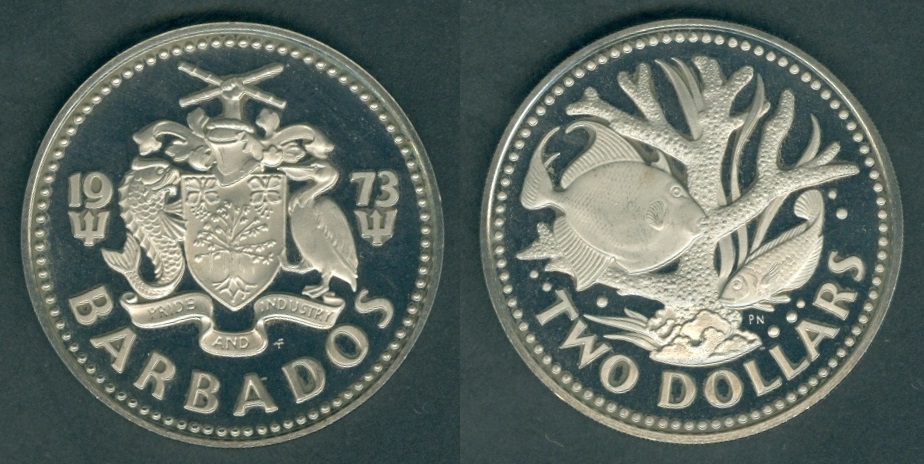 |
|
KM#15
/ Schön# 7
2 Dollars. Year:
1973. Weight:
19.83g [20.00 g]. Metal:
Copper-Nickel.
Diameter:
35.50 mm [37.00 mm].
Edge:
Reeded. Alignment:
Medal. Mint:
The Franklin Mint, Wawa,
United States ("f" mintmark above D in BARBADOS).
Obverse:
Barbados Coat and Arms
with motto on banner "PRIDE AND INDUSTRY" in the center. The first
two digits of Date on left side with small trident below it and last
two digits of Date on the right side with a small trident below it
as well. "BARBADOS" written at the bottom
section.
Reverse:
Staghorn coral (Acropora
cervicornis) and two fishes going round the coral in the center. Value "TWO
DOLLARS" written at the bottom section.
Mintage:
97,000.
Minted Years:
1973 FM Matte, 1973 FM Proof,
1974 FM Matte, 1974
FM Proof, 1975 FM Matte, 1975 FM Proof, 1975 FM Special Uncirculated,
1977 FM Matte, 1977 FM Proof, 1977 FM Special Uncirculated, 1978 FM Matte, 1978 FM Proof, 1978 FM Special Uncirculated, 1979 FM Matte, 1979 FM Proof, 1979
FM Special Uncirculated, 1980 FM Matte, 1980 FM
Proof, 1980 FM Special Uncirculated, 1981 FM
Matte, 1981 FM Proof, 1981 FM Special Uncirculated, 1982 FM Proof, 1982 FM Special Uncirculated,
1983 FM Proof, 1983 FM Special Uncirculated, 1984 FM Proof and 1984
FM Special Uncirculated.
Engraver:
Philip Nathan (both sides).
The staghorn coral (Acropora
cervicornis) is a branching, stony coral with cylindrical
branches ranging from a few centimetres to over two metres in length
and height. It occurs in back reef and fore reef environments from 0
to 30 m (0 to 98 ft) depth. The upper limit is defined by wave
forces, and the lower limit is controlled by suspended sediments and
light availability. Fore reef zones at intermediate depths 5–25 m
(16–82 ft) were formerly dominated by extensive single-species
stands of staghorn coral until the mid-1980s. This coral exhibits
the fastest growth of all known western Atlantic fringe corals, with
branches increasing in length by 10–20 cm (3.9–7.9 in) per year.
This has been one of the three most important Caribbean corals in
terms of its contribution to reef growth and fishery habitat. They
are now under Critically Endangered status. Staghorn coral is found
throughout the Florida Keys, the Bahamas, and the Caribbean islands.
This coral occurs in the western Gulf of Mexico, but is absent from
U.S. waters in the Gulf of Mexico, as well as Bermuda and the west
coast of South America. The northern limit is on the east coast of
Florida, around Palm Beach, Florida. In South-East Asia, it grows
rapidly and abundantly in the reefs of the coasts of Sabah,
Malaysia. |
|
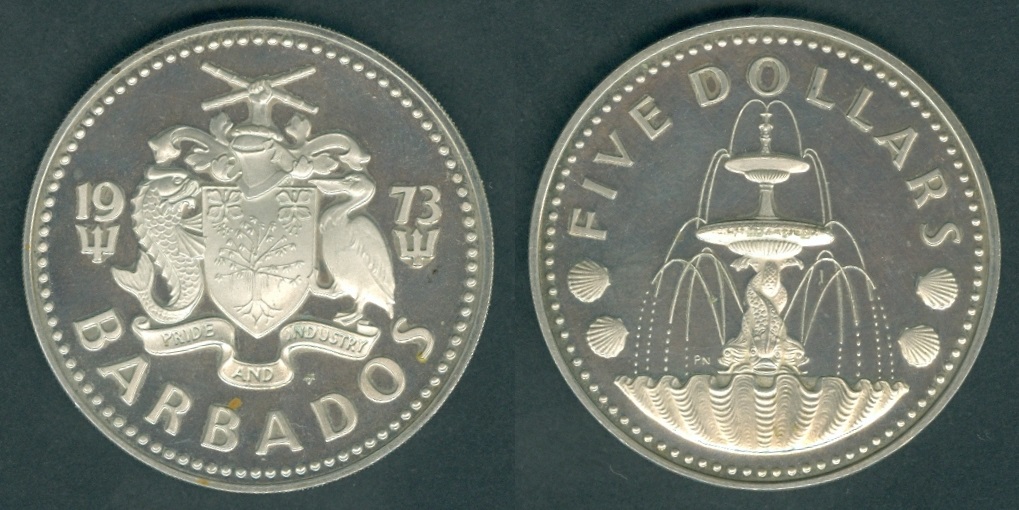 |
|
KM#16a
/ Schön# 8a
5 Dollars. Year:
1973 Proof. Weight:
31.30g [31.10 g]. Metal:
0.800 Silver.
Diameter:
39.00 mm [40.00 mm].
Edge:
Reeded. Alignment:
Medal. Mint:
The Franklin Mint, Wawa,
United States ("f" mintmark above D in BARBADOS).
Obverse:
Barbados Coat and Arms
with motto on banner "PRIDE AND INDUSTRY" in the center. The first
two digits of Date on left side with small trident below it and last
two digits of Date on the right side with a small trident below it
as well. "BARBADOS" written at the bottom
section.
Reverse:
Value "FIVE DOLLARS" written at the
top section. Shell Fountain in Bridgetown's Trafalgar Square, in the
center. Two sea shells each on lower left side and lower right side.
Mintage:
97,000.
Minted Years:
1973 FM Matte, 1973 FM Proof,
1974
FM Proof, 1975 FM Proof, 1977 FM Proof, 1978 FM Proof, 1979 FM
Proof, 1980 FM Proof, 1981 FM Proof, 1982 FM Proof, 1983 FM Proof,
and 1984 FM Proof.
Engraver:
Philip Nathan (both sides).
Note:
KM#8 exists in Copper-Nickel and were
produced in and as:
- 1974 FM Matte
- 1975 FM Matte
- 1975 FM Special Uncirculated
- 1977 FM Matte
- 1977 FM Special Uncirculated
- 1978 FM Special Uncirculated
- 1979 FM Matte
- 1979 FM Special Uncirculated
- 1980 FM Matte
- 1980 FM Special Uncirculated
- 1981 FM Matte
- 1981 FM Special Uncirculated
- 1982 Proof
- 1982 FM Special Uncirculated
- 1983 FM Matte
- 1983 FM Special Uncirculated
- 1984 FM.
|
|
| |
|
1975 |
| |
|
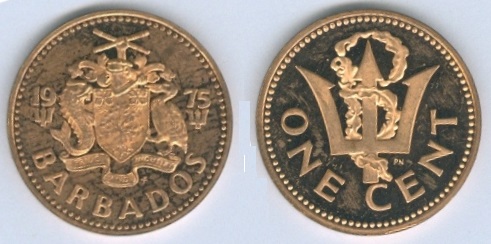 |
Same as above
KM#10, 1 cent, but...
Year: 1975 FM Proof.
Weight: 3.05 g
[3.10g]. Mint:
The Franklin Mint, Wawa,
United States ("f" mintmark above D in BARBADOS).
Mintage:
20,458.
Type1:
Heavy type. |
|
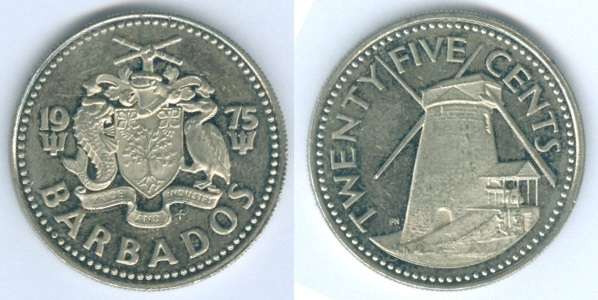 |
Same as above
KM#13, 25 cents, but...
Year: 1975 FM Proof.
Weight: 5.78 g
[5.67g]. Mint:
The Franklin Mint, Wawa,
United States ("f" mintmark above D in BARBADOS).
Mintage:
20,000.
Type1:
Heavy type and non-magnetic. |
|
| |
|
1978 |
| |
|
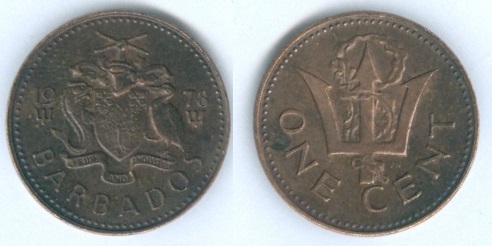 |
Same as above
KM#10, 1 cent, but...
Year: 1978.
Weight: 3.14 g
[3.10g]. Mint:
Royal Canadian Mint.
Mintage: 4,807,000.
Type1:
Heavy type. |
|
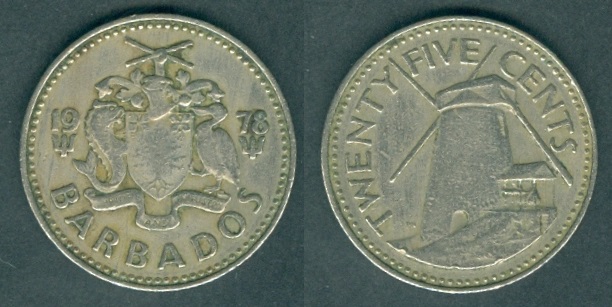 |
Same as above
KM#13, 25 cents, but...
Year: 1978.
Weight: 5.66 g
[5.67g]. Mint:
Royal Canadian Mint.
Mintage: 2,407,000.
Type1:
Heavy type and non-magnetic. |
|
| |
|
1979 |
| |
|
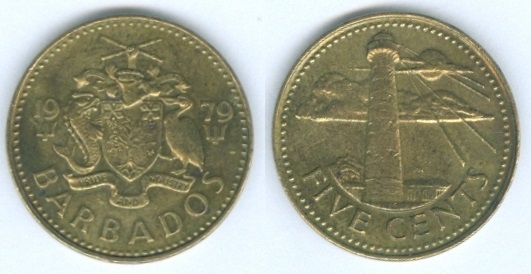 |
Same as above
KM#11, 5 cents, but...
Year: 1979.
Weight: 3.72 g
[3.75g]. Mint:
Royal Canadian Mint.
Mintage:
4,800,000.
Type1:
Heavy type and non-magnetic. |
|
 |
Same as above
KM#11, 5 cents, but...
Year: 1979 FM Proof.
Weight: 3.85 g
[3.75g]. Mint:
The Franklin Mint, Wawa,
United States ("f" mintmark above D in BARBADOS).
Mintage:
4,126.
Type1:
Heavy type and non-magnetic. |
|
 |
Same as above
KM#14.1, 1 Dollar, but...
Year: 1979.
Weight: 10.08 g
[10.00g]. Mint:
Royal Canadian Mint.
Mintage:
2,000,000.
Type1:
Heavy type and non-magnetic. |
|
| |
|
1980 |
| |
|
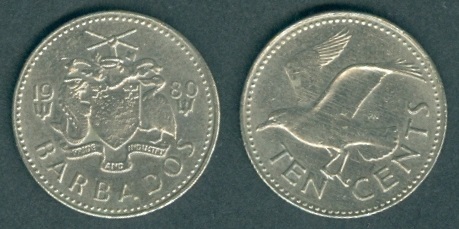 |
Same as above
KM#12, 10 cents, but...
Year: 1980.
Weight: 2.15 g
[2.29g]. Mint:
Royal Canadian Mint.
Mintage:
3,500,000.
Type1:
Heavy type and non-magnetic. |
|
| |
|
1981 |
| |
|
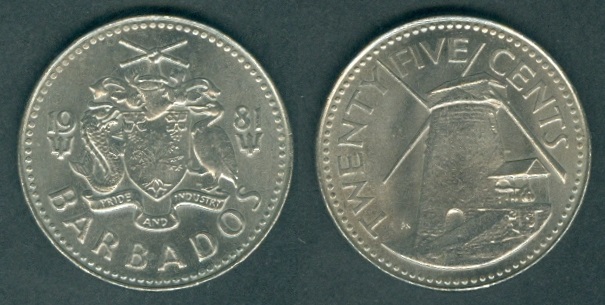 |
Same as above
KM#13, 25 cents, but...
Year: 1981.
Weight: 5.62 g
[5.67g]. Mint:
Royal Canadian Mint.
Mintage: 4,365,000.
Type1:
Heavy type and non-magnetic. |
|
| |
|
1982 |
| |
|
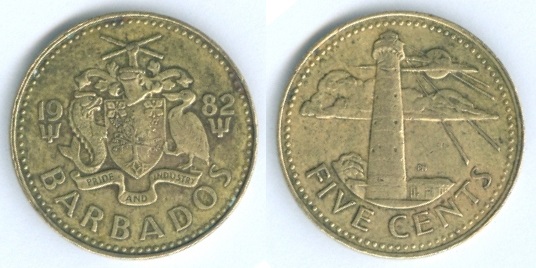 |
Same as above
KM#11, 5 cents, but...
Year: 1982.
Weight: 3.74 g
[3.75g]. Mint:
Royal Canadian Mint.
Mintage:
2,100,000.
Type1:
Heavy type and non-magnetic. |
|
| |
|
1983 |
| |
|
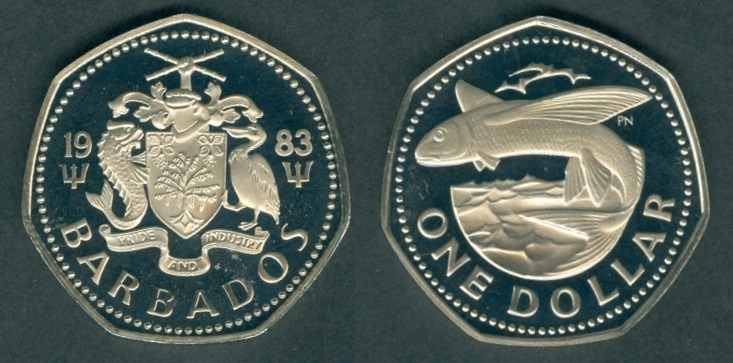 |
Same as above
KM#14.1, 1 Dollar, but...
Year: 1983 FM Proof.
Weight: 9.98 g
[10.00g]. Mint:
The Franklin Mint, Wawa,
United States ("f" mintmark above D in BARBADOS).
Mintage:
459.
This coin is more thicker than the normal
issue but retaining the same weight limit.
Type1:
Heavy type and non-magnetic. |
|
| |
|
1984 |
| |
|
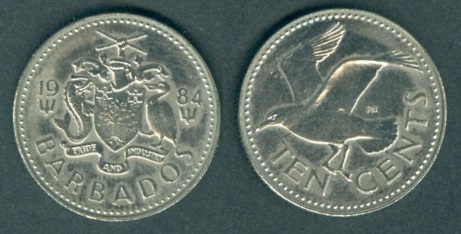 |
Same as above
KM#12, 10 cents, but...
Year: 1984.
Weight: 2.29 g
[2.29g]. Mint:
Royal Canadian Mint.
Mintage:
N/A.
Type1:
Heavy type and non-magnetic. |
|
| |
|
1985 |
| |
|
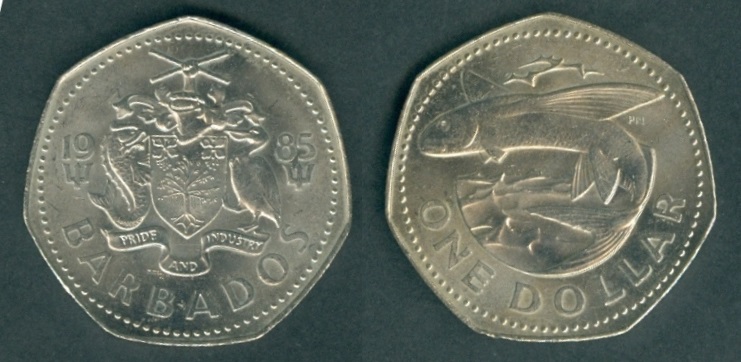 |
Same as above
KM#14.1, 1 Dollar, but...
Year: 1985.
Weight: 10.00 g
[10.00g]. Mint:
Royal Canadian Mint.
Mintage:
N/A.
Type1:
Heavy type and non-magnetic. |
|
| |
|
1986 |
| |
|
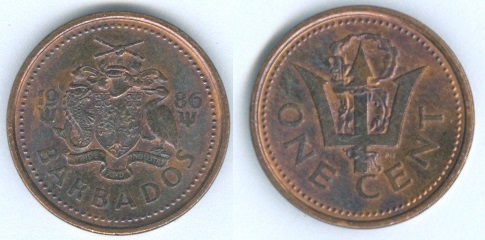 |
Same as above
KM#10, 1 cent, but...
Year: 1986.
Weight: 3.10 g
[3.10g]. Mint:
British Royal Mint, UK.
Mintage:
N/A.
Type1:
Heavy type. |
|
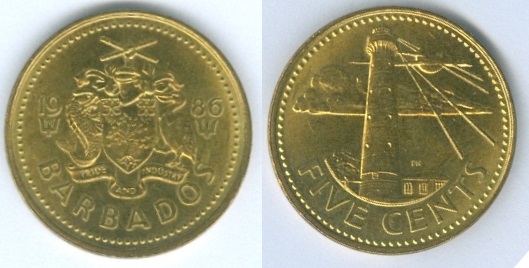 |
Same as above
KM#11, 5 cents, but...
Year: 1986.
Weight: 3.73 g
[3.75g]. Mint:
Royal Canadian Mint.
Mintage: N/A.
Type1:
Heavy type and non-magnetic. |
|
| |
|
1987 |
| |
|
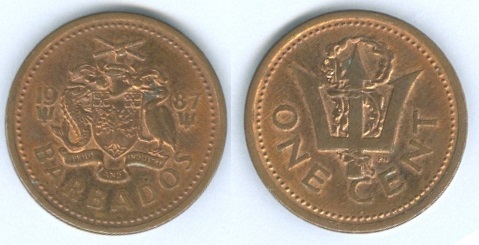 |
KM#10a
/ Schön# 2a
1
Cent. Year:
1987. Weight:
2.54g [2.50 g]. Metal:
Copper plated zinc
(non-magnetic).
Diameter:
18.50 mm.
Thickness: 1.55 mm.
Edge:
Plain. Alignment:
Medal. Mint:
Royal Canadian Mint. |
|
Obverse:
Barbados Coat and Arms
with motto on banner "PRIDE AND INDUSTRY" in the center. The first
two digits of Date on left side with small trident below it and last
two digits of Date on the right side with a small trident below it
as well. "BARBADOS" written at the bottom
section.
Reverse:
Large trident with
trailing leaves within it, in the center.
Value "ONE CENT" written at the bottom section.
Mintage:
N/A.
Minted Years:
1987, 1989, 1990, 1991, 1992, 1993, 1995, 1996, 1997, 1998,
1999, 2000, 2001, 2002, 2003, 2004, 2005, 2006 and 2007 (all years =
Royal Canadian Mint).
Engraver:
Philip Nathan (both sides). |
|
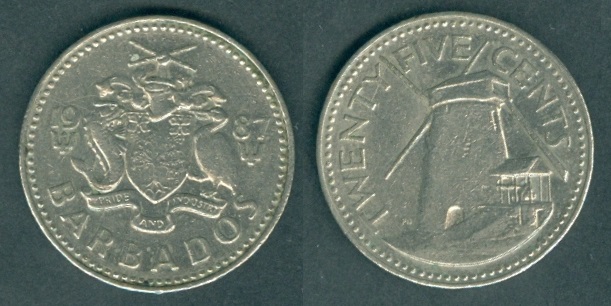 |
Same as above
KM#13, 25 cents, but...
Year: 1987.
Weight: 5.70 g
[5.67g]. Mint:
Royal Canadian Mint.
Mintage: 3,150,000.
Type1:
Heavy type and non-magnetic. |
|
| |
|
1989 |
| |
|
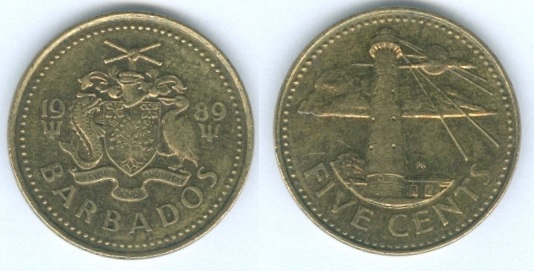 |
Same as above
KM#11, 5 cents, but...
Year: 1989.
Weight: 3.76 g
[3.75g]. Mint:
British Royal mint.
Mintage: N/A.
Type1:
Heavy type and non-magnetic. |
|
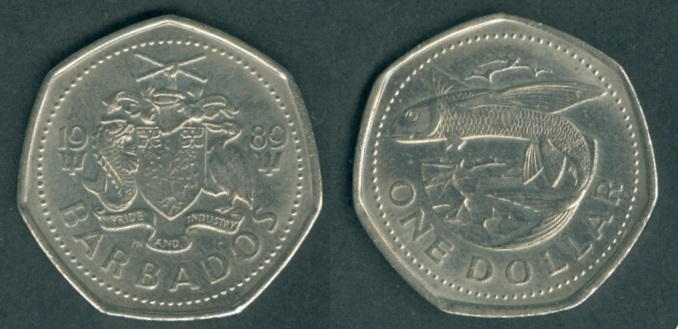 |
KM#14.2
/ Schön# A6
1 Dollar. Year:
1989. Weight:
6.32g [6.32 g]. Metal:
Copper-Nickel.
Diameter:
25.85 mm; Heptagonal (7-sided).
Thickness: 1.65 mm.
Edge:
Plain. Alignment:
Medal. Mint:
British Royal Mint. Type2:
Small type; non-magnetic. |
|
Obverse:
Barbados Coat and Arms
with motto on banner "PRIDE AND INDUSTRY" in the center. The first
two digits of Date on left side with small trident below it and last
two digits of Date on the right side with a small trident below it
as well. "BARBADOS" written at the bottom
section.
Reverse:
Flying fish facing left, jumping above
water in the center. Value "ONE DOLLAR" written at the bottom
section.
Mintage:
N/A.
Minted Years:
1988 (British Royal Mint),
1989 (British Royal Mint), 1994 (Royal Canadian Mint), 1997 (Royal
Canadian Mint), 1998 (Royal Canadian Mint), 2000 (Royal Canadian
Mint), 2004 (Royal Canadian Mint) and 2005 (Royal Canadian Mint).
Engraver:
Philip Nathan (both sides). |
|
| |
|
1990 |
| |
|
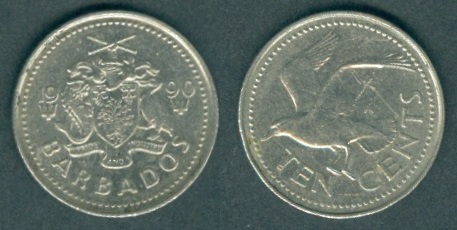 |
Same as above
KM#12, 10 cents, but...
Year: 1990.
Weight: 2.26 g
[2.29g]. Mint:
British Royal mint.
Mintage:
N/A.
Type1:
Heavy type and non-magnetic. |
|
 |
Same as above
KM#13, 25 cents, but...
Year: 1990.
Weight: 5.71 g
[5.67g]. Mint:
British Royal mint.
Mintage: 3,150,000.
Type1:
Heavy type and non-magnetic. |
|
| |
|
1992 |
| |
|
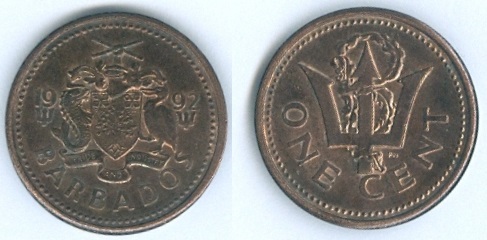 |
Same as above
KM#10a, 1 cent, but...
Year: 1992.
Weight: 2.50 g
[2.50g]. Mint:
Royal Canadian Mint.
Mintage:
N/A.
Type2a:
Light type and non-magnetic. |
|
 |
Same as above
KM#12, 10 cents, but...
Year: 1992.
Weight: 2.29 g
[2.29g]. Mint:
Royal Canadian Mint.
Mintage:
N/A.
Type1:
Heavy type and non-magnetic. |
|
| |
|
1994 |
| |
|
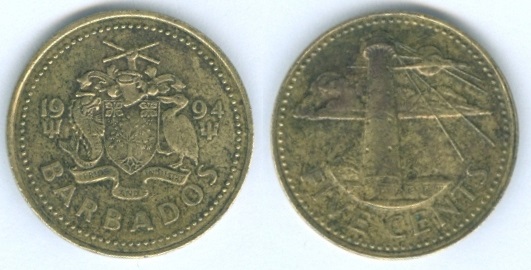 |
Same as above
KM#11, 5 cents, but...
Year: 1994.
Weight: 3.78 g
[3.75g]. Mint:
Royal Canadian Mint.
Mintage: N/A.
Type1:
Heavy type and non-magnetic. |
|
 |
Same as above
KM#13, 25 cents, but...
Year: 1994.
Weight: 5.72 g
[5.67g]. Mint:
Royal Canadian Mint.
Mintage: N/A.
Type1:
Heavy type and non-magnetic. |
|
| |
|
1995 |
| |
|
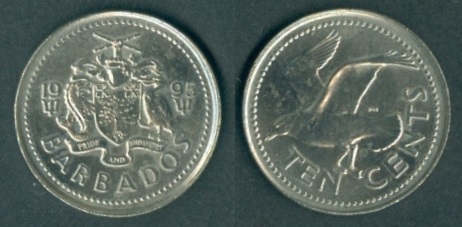 |
Same as above
KM#12, 10 cents, but...
Year: 1995.
Weight: 2.32 g
[2.29g]. Mint:
Royal Canadian Mint.
Mintage:
N/A.
Type1:
Heavy type and non-magnetic. |
|
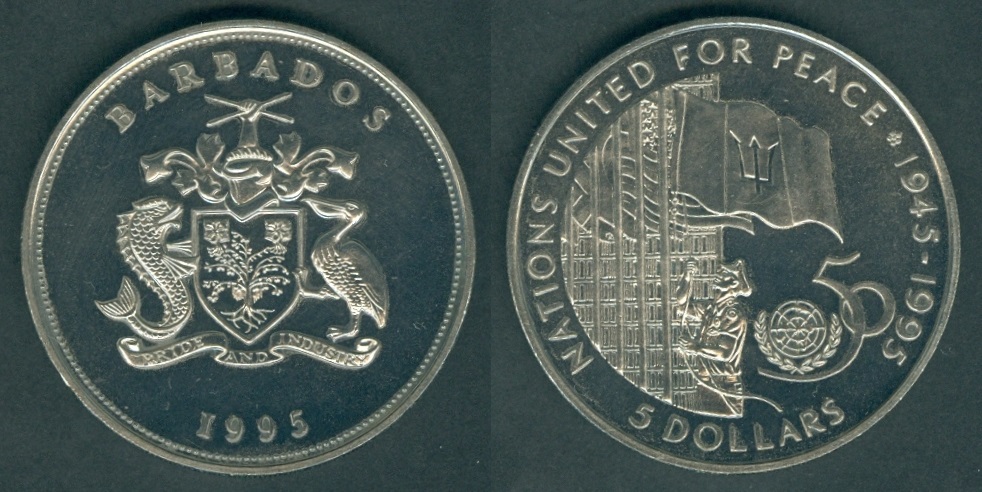 |
|
KM#62 /
Schön#
57
5
Dollars. Year:
1995. Weight:
27.94g [28.28g]. Metal:
Copper-Nickel. Edge:
Reeded. Diameter:
38.00 mm [38.61 mm].
Alignment:
Medal. Mint:
British Royal Mint.
Obverse: "BARBADOS" written at the top. Barbados Coat and Arms
in the center with Motto: "PRIDE AND INDUSTRY". Date "1995"
at the bottom.
Reverse: A military man raising Barbados Flag
in front of several flag with United Nations building in the
background, in the center. Logo of United Nations 50 years at the
lower right side. "NATIONS UNITED FOR PEACE * 1945-1995" in circular
form near the edge. Value "5 DOLLARS" written at the bottom.
Mintage:
N/A.
Minted Years: One year
type. Subject: 50
years of United Nations.
Note: KM#62a
exists in 0.925 Silver with weight 28.28 g. Mintage: 15,000
(estimated). |
|
| |
|
1996 |
| |
|
 |
Same as above
KM#10a, 1 cent, but...
Year: 1996.
Weight: 2.48 g
[2.50g]. Mint:
Royal Canadian Mint.
Mintage:
N/A.
Type2a:
Light type and non-magnetic. |
|
 |
Same as above coin but Dark in colour.
Weight: 2.51 g
[2.50g]. |
|
 |
Same as above
KM#11, 5 cents, but...
Year: 1996.
Weight: 3.76 g
[3.75g]. Mint:
Royal Canadian Mint.
Mintage: N/A.
Type1:
Heavy type and non-magnetic. |
|
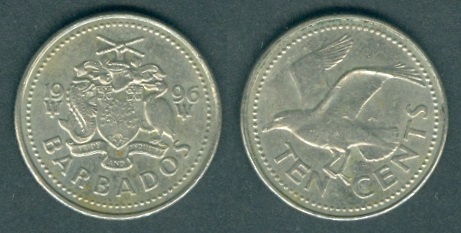 |
Same as above
KM#12, 10 cents, but...
Year: 1996.
Weight: 2.28 g
[2.29g]. Mint:
Royal Canadian Mint.
Mintage:
N/A.
Type1:
Heavy type and non-magnetic. |
|
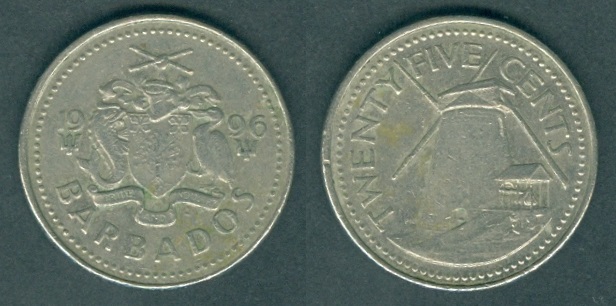 |
Same as above
KM#13, 25 cents, but...
Year: 1996.
Weight: 5.72 g
[5.67g]. Mint:
Royal Canadian Mint.
Mintage: N/A.
Type1:
Heavy type and non-magnetic. |
|
| |
|
1998 |
| |
|
 |
Same as above
KM#10a, 1 cent, but...
Year: 1998.
Weight: 2.50 g
[2.50g]. Mint:
Royal Canadian Mint.
Mintage:
N/A.
Type2a:
Light type and non-magnetic. |
|
 |
Same as above
KM#11, 5 cents, but...
Year: 1998.
Weight: 3.83 g
[3.75g]. Mint:
Royal Canadian Mint.
Mintage: N/A.
Type1:
Heavy type and non-magnetic. |
|
 |
Same as above
KM#12, 10 cents, but...
Year: 1998.
Weight: 2.29 g
[2.29g]. Mint:
Royal Canadian Mint.
Mintage:
N/A.
Type1:
Heavy type and non-magnetic. |
|
 |
Same as above
KM#13, 25 cents, but...
Year: 1998.
Weight: 5.70 g
[5.67g]. Mint:
Royal Canadian Mint.
Mintage: N/A.
Type1:
Heavy type and non-magnetic. |
|
 |
Same as above
KM#14.2, 1 Dollar, but...
Year: 1998.
Weight: 6.31 g
[6.32g]. Mint:
Royal Canadian Mint.
Mintage:
N/A.
Type2:
Small type; non-magnetic. |
|
| |
|
1999 |
| |
|
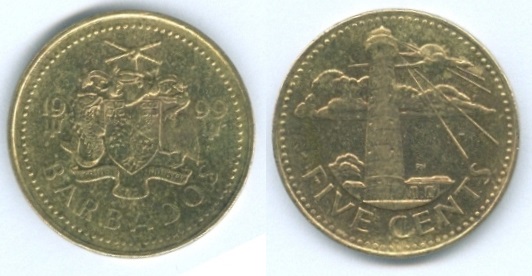 |
Same as above
KM#11, 5 cents, but...
Year: 1999.
Weight: 3.79 g
[3.75g]. Mint:
Royal Canadian Mint.
Mintage: N/A.
Type1:
Heavy type and non-magnetic. |
|
| |
|
2000 |
| |
|
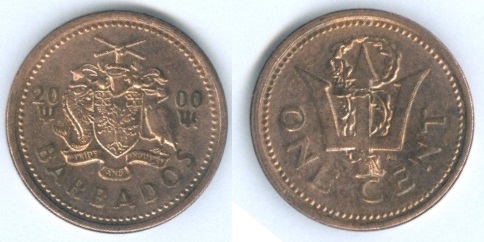 |
Same as above
KM#10a, 1 cent, but...
Year: 2000.
Weight: 2.50 g
[2.50g]. Mint:
Royal Canadian Mint.
Mintage:
N/A.
Type2a:
Light type and non-magnetic. |
|
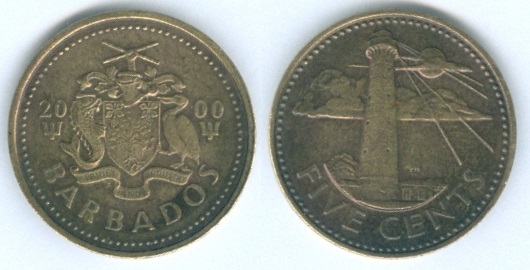 |
Same as above
KM#11, 5 cents, but...
Year: 2000.
Weight: 3.76 g
[3.75g]. Mint:
Royal Canadian Mint.
Mintage: N/A.
Type1:
Heavy type and non-magnetic. |
|
| |
|
2001 |
| |
|
 |
Same as above
KM#10a, 1 cent, but...
Year: 2001.
Weight: 2.50 g
[2.50g]. Mint:
Royal Canadian Mint.
Mintage:
N/A.
Type2a:
Light type and non-magnetic. |
|
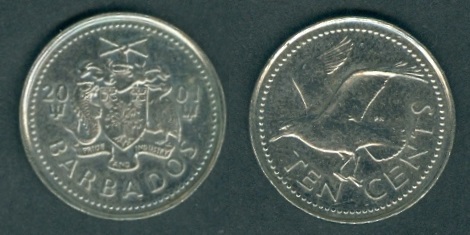 |
Same as above
KM#12, 10 cents, but...
Year: 2001.
Weight: 2.28 g
[2.29g]. Mint:
Royal Canadian Mint.
Mintage:
N/A.
Type1:
Heavy type and non-magnetic. |
|
| |
|
2002 |
| |
|
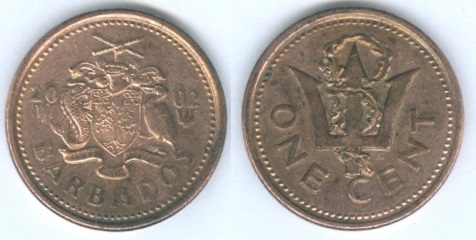 |
Same as above
KM#10a, 1 cent, but...
Year: 2002.
Weight: 2.47 g
[2.50g]. Mint:
Royal Canadian Mint.
Mintage:
N/A.
Type2a:
Light type and non-magnetic. |
|
| |
|
2003 |
| |
|
 |
Same as above
KM#12, 10 cents, but...
Year: 2003.
Weight: 2.29 g
[2.29g]. Mint:
Royal Canadian Mint.
Mintage:
N/A.
Type1:
Heavy type and non-magnetic. |
|
 |
Same as above
KM#13, 25 cents, but...
Year: 2003.
Weight: 5.65 g
[5.67g]. Mint:
Royal Canadian Mint.
Mintage: N/A.
Type1:
Heavy type and non-magnetic. |
|
| |
|
2004 |
| |
|
 |
Same as above
KM#10a, 1 cent, but...
Year: 2004.
Weight: 2.50 g
[2.50g]. Mint:
Royal Canadian Mint.
Mintage:
N/A.
Type2a:
Light type and non-magnetic. |
|
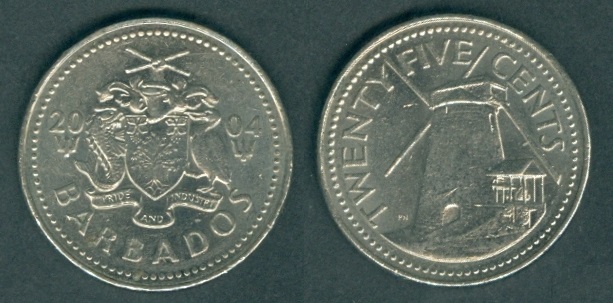 |
Same as above
KM#13, 25 cents, but...
Year: 2004.
Weight: 5.63 g
[5.67g]. Mint:
Royal Canadian Mint.
Mintage: N/A.
Type1:
Heavy type and non-magnetic. |
|
 |
Same as above
KM#14.2, 1 Dollar, but...
Year: 2004.
Weight: 6.30 g
[6.32g]. Mint:
Royal Canadian Mint.
Mintage:
N/A.
Type2:
Small type; non-magnetic. |
|
| |
|
2005 |
| |
|
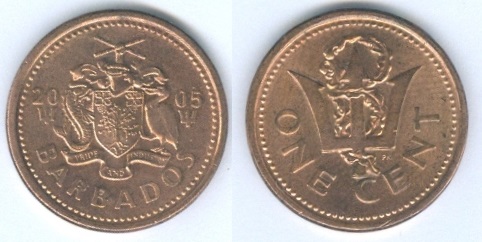 |
Same as above
KM#10a, 1 cent, but...
Year: 2005.
Weight: 2.48 g
[2.50g]. Mint:
Royal Canadian Mint.
Mintage:
N/A.
Type2a:
Light type and non-magnetic. |
|
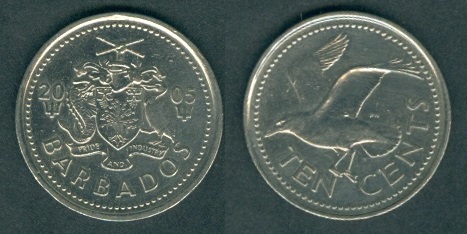 |
Same as above
KM#12, 10 cents, but...
Year: 2005.
Weight: 2.24 g
[2.29g]. Mint:
Royal Canadian Mint.
Mintage:
N/A.
Type1:
Heavy type and non-magnetic. |
|
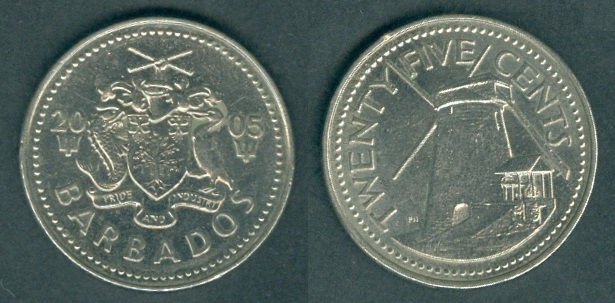 |
Same as above
KM#13, 25 cents, but...
Year: 2005.
Weight: 5.63 g
[5.67g]. Mint:
Royal Canadian Mint.
Mintage: N/A.
Type1:
Heavy type and non-magnetic. |
|
| |
|
2006 |
| |
|
 |
Same as above
KM#10a, 1 cent, but...
Year: 2006.
Weight: 2.48 g
[2.50g]. Mint:
Royal Canadian Mint.
Mintage:
N/A.
Type2a:
Light type and non-magnetic. |
|
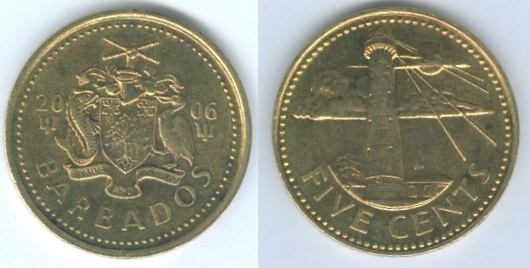 |
Same as above
KM#11, 5 cents, but...
Year: 2006.
Weight: 3.80 g
[3.75g]. Mint:
Royal Canadian Mint.
Mintage: N/A.
Type1:
Heavy type and non-magnetic. |
|
| |
|
2007 |
| |
|
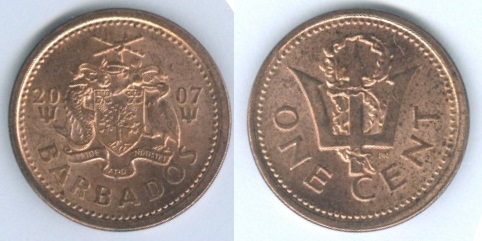 |
KM#10b
/ Schön# 2b
1
Cent. Year:
2007. Weight:
2.81g [2.78 g]. Metal:
Copper plated Steel (magnetic).
Diameter:
18.50 mm.
Thickness: 1.55 mm.
Edge:
Plain. Alignment:
Medal. Mint:
Royal Canadian Mint. |
|
Obverse:
Barbados Coat and Arms
with motto on banner "PRIDE AND INDUSTRY" in the center. The first
two digits of Date on left side with small trident below it and last
two digits of Date on the right side with a small trident below it
as well. "BARBADOS" written at the bottom
section.
Reverse:
Large trident with
trailing leaves within it, in the center.
Value "ONE CENT" written at the bottom section.
Mintage:
N/A.
Minted Years:
2007, 2008, 2009, 2010, 2011 and 2012
(all years = Royal Canadian Mint).
Engraver:
Philip Nathan (both sides). |
|
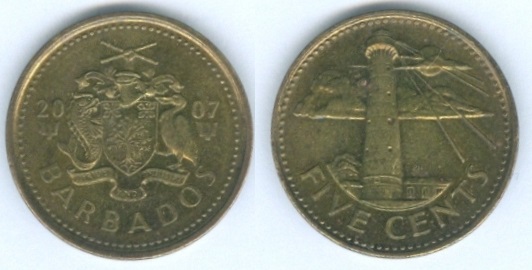 |
KM#11a
/ Schön# 3a
5
Cents. Year:
2007. Weight:
3.50g [3.50 g]. Metal:
Brass
plated Steel.
Diameter:
21.00 mm.
Thickness: 1.67 mm.
Edge:
Plain. Alignment:
Medal. Mint:
Royal
Canadian Mint.
Type2:
Light type and magnetic. |
|
Obverse:
Barbados Coat and Arms
with motto on banner "PRIDE AND INDUSTRY" in the center. The first
two digits of Date on left side with small trident below it and last
two digits of Date on the right side with a small trident below it
as well. "BARBADOS" written at the bottom
section.
Reverse:
South Point Lighthouse with four light rays
pointing downwards in the center with it's tower above clouds. Moon
in the clouds at the upper right side. Value "FIVE CENTS" written at the bottom section.
Mintage:
N/A.
Minted Years:
2007,
2008, 2009, 2010, 2011, 2012, 2014, 2016, 2017, 2018 and 2019 (all
years = Royal Canadian Mint).
Engraver:
Philip Nathan (both sides). |
|
 |
KM#13a
/ Schön# 5a
25
Cents. Year:
1973. Weight:
5.15g [5.10 g]. Metal:
Nickel plated steel.
Diameter:
23.00 mm.
Thickness: 1.82 mm.
Edge:
Reeded. Alignment:
Medal. Mint:
Royal
Canadian Mint.
Type2:
Light type and magnetic. |
|
Obverse:
Barbados Coat and Arms
with motto on banner "PRIDE AND INDUSTRY" in the center. The first
two digits of Date on left side with small trident below it and last
two digits of Date on the right side with a small trident below it
as well. "BARBADOS" written at the bottom
section.
Reverse:
Value "TWENTY FIVE CENTS" written
at the top section. The Morgan Lewis Windmillm at St. Andrew in the center.
Mintage:
N/A.
Minted Years:
2007,
2008, 2009 and 2011 (all
years = Royal Canadian Mint).
Engraver:
Philip Nathan (both sides). |
|
 |
KM#14.2a
/ Schön# A6a
1 Dollar. Year:
2007. Weight:
5.58g [5.95 g]. Metal:
Nickel plated Steel.
Diameter:
25.85 mm; Heptagonal (7-sided).
Thickness: 1.65 mm.
Edge:
Plain. Alignment:
Medal. Mint:
British Royal Mint. Type3:
Small type; magnetic. |
|
Obverse:
Barbados Coat and Arms
with motto on banner "PRIDE AND INDUSTRY" in the center. The first
two digits of Date on left side with small trident below it and last
two digits of Date on the right side with a small trident below it
as well. "BARBADOS" written at the bottom
section.
Reverse:
Flying fish facing left, jumping above
water in the center. Value "ONE DOLLAR" written at the bottom
section.
Mintage:
N/A.
Minted Years:
2007 (Royal
Canadian Mint), 2008 (Royal Canadian Mint) and 2009 (Royal Canadian Mint).
Engraver:
Philip Nathan (both sides). |
|
| |
|
2008 |
| |
|
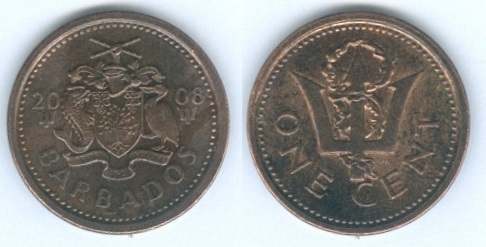 |
Same as above
KM#10b, 1 cent, but...
Year: 2008.
Weight: 2.79 g
[2.78g]. Mint:
Royal Canadian Mint.
Mintage:
N/A.
Type2b:
Light type and magnetic. |
|
 |
Same as above
KM#11a, 5 cents, but...
Year: 2008.
Weight: 3.49 g
[3.50g]. Mint:
Royal Canadian Mint.
Mintage:
N/A.
Type2:
Light type and magnetic. |
|
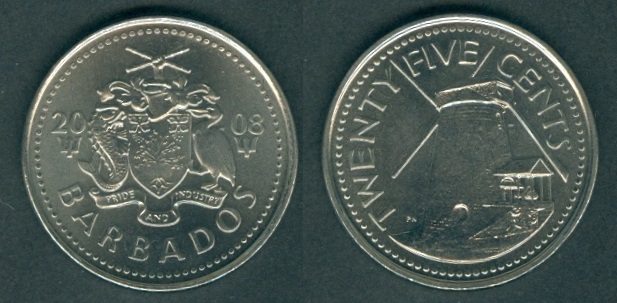 |
Same as above
KM#13a, 25 cents, but...
Year: 2008.
Weight: 5.10 g
[5.10g]. Mint:
Royal Canadian Mint.
Mintage: N/A.
Type2:
Light type and magnetic. |
|
| |
|
2009 |
| |
|
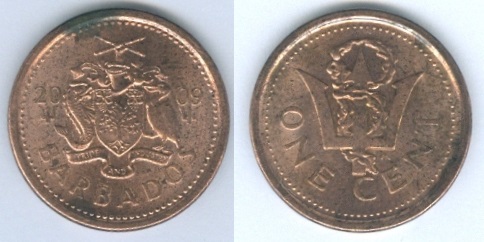 |
Same as above
KM#10b, 1 cent, but...
Year: 2009.
Weight: 2.78 g
[2.78g]. Mint:
Royal Canadian Mint.
Mintage:
N/A.
Type2b:
Light type and magnetic. |
|
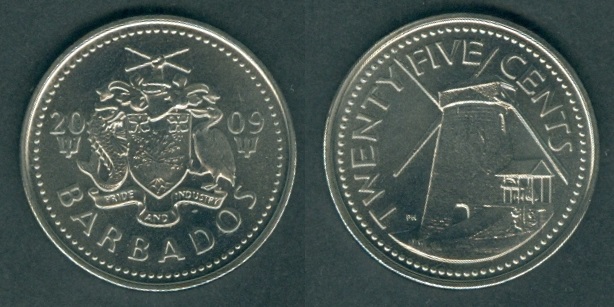 |
Same as above
KM#13a, 25 cents, but...
Year: 2009.
Weight: 5.05 g
[5.10g]. Mint:
Royal Canadian Mint.
Mintage: N/A.
Type2:
Light type and magnetic. |
|
| |
|
2010 |
| |
|
 |
Same as above
KM#10b, 1 cent, but...
Year: 2010.
Weight: 2.80 g
[2.78g]. Mint:
Royal Canadian Mint.
Mintage:
N/A.
Type2b:
Light type and magnetic. |
|
 |
Same as above
KM#11a, 5 cents, but...
Year: 2010.
Weight: 3.47 g
[3.50g]. Mint:
Royal Canadian Mint.
Mintage:
N/A.
Type2:
Light type and magnetic. |
|
| |
|
2011 |
| |
|
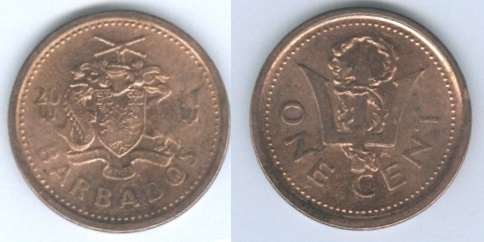 |
Same as above
KM#10b, 1 cent, but...
Year: 2011.
Weight: 2.80 g
[2.78g]. Mint:
Royal Canadian Mint.
Mintage:
N/A.
Type2b:
Light type and magnetic. |
|
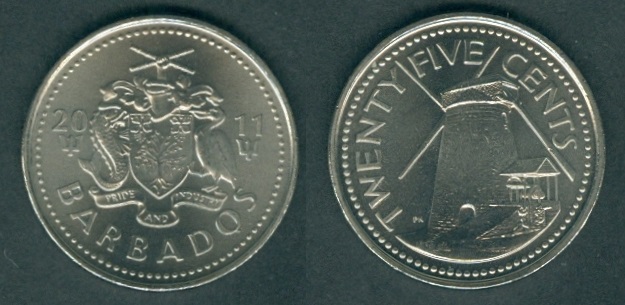 |
Same as above
KM#13a, 25 cents, but...
Year: 2011.
Weight: 5.14 g
[5.10g]. Mint:
Royal Canadian Mint.
Mintage: N/A.
Type2:
Light type and magnetic. |
|
| |
|
2012 |
| |
|
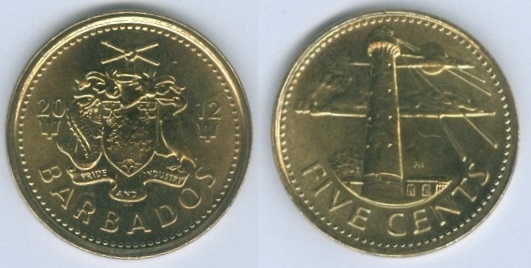 |
Same as above
KM#11a, 5 cents, but...
Year: 2012.
Weight: 3.47 g
[3.50g]. Mint:
Royal Canadian Mint.
Mintage:
N/A.
Type2:
Light type and magnetic. |
|
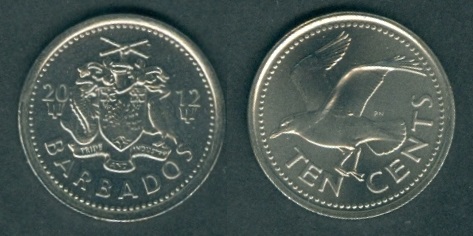 |
KM#12a
/ Schön# 4a
10
Cents. Year:
2012. Weight:
2.06g [2.09 g]. Metal:
Nickel plated Steel.
Diameter:
17.25 mm.
Thickness: 1.35 mm.
Edge:
Reeded. Alignment:
Medal. Mint:
Royal
Canadian Mint.
Type2:
Light type and magnetic. |
|
Obverse:
Barbados Coat and Arms
with motto on banner "PRIDE AND INDUSTRY" in the center. The first
two digits of Date on left side with small trident below it and last
two digits of Date on the right side with a small trident below it
as well. "BARBADOS" written at the bottom
section.
Reverse:
Laughing Gull flying
left in the center. Value "TEN CENTS" written at the bottom section.
Mintage:
4,000,000. Mintage:
N/A.
Minted Years:
2007,
2008, 2009, 2012, 2016, 2017, 2018 and 2019 (all
years = Royal Canadian Mint).
Engraver:
Philip Nathan (both sides). |
|
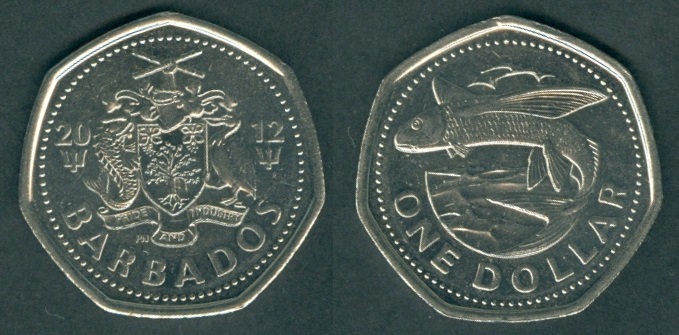 |
KM#14.2b
/ Schön# A6b
1 Dollar. Year:
2012. Weight:
5.50g [5.50 g]. Metal:
Nickel plated Steel.
Diameter:
25.90 mm; Heptagonal (7-sided).
Thickness: 1.65 mm.
Edge:
Plain. Alignment:
Medal. Mint:
British Royal Mint. Type4:
Small and light type; magnetic. Weight reduced from 5.95 to 5.50
grams. |
|
Obverse:
Barbados Coat and Arms
with motto on banner "PRIDE AND INDUSTRY" in the center. The first
two digits of Date on left side with small trident below it and last
two digits of Date on the right side with a small trident below it
as well. "BARBADOS" written at the bottom
section.
Reverse:
Flying fish facing left, jumping above
water in the center. Value "ONE DOLLAR" written at the bottom
section.
Mintage:
N/A.
Minted Years:
2012
(Royal Canadian Mint), 2015 (Royal Canadian Mint), 2016 (Royal
Canadian Mint) and 2017 (Royal Canadian Mint).
Engraver:
Philip Nathan (both sides). |
|
| |
|
2014 |
| |
|
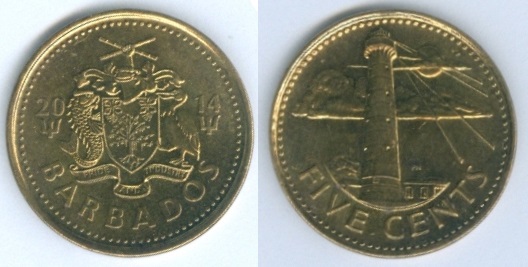 |
Same as above
KM#11a, 5 cents, but...
Year: 2014.
Weight: 3.46 g
[3.50g]. Mint:
Royal Canadian Mint.
Mintage:
N/A.
Type2:
Light type and magnetic. |
|
| |
|
2015 |
| |
|
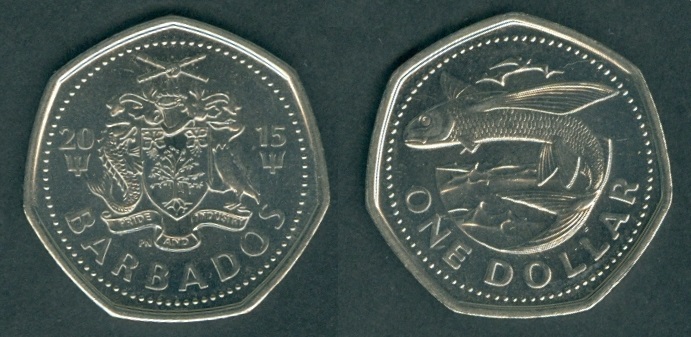 |
Same as above
KM#14.2b, 1 Dollar, but...
Year: 2015.
Weight: 5.48 g
[5.50g]. Mint:
Royal Canadian Mint.
Mintage:
N/A.
Type4:
Small and light type; magnetic. Weight reduced from 5.95 to 5.50
grams. |
|
| |
|
2016 |
| |
|
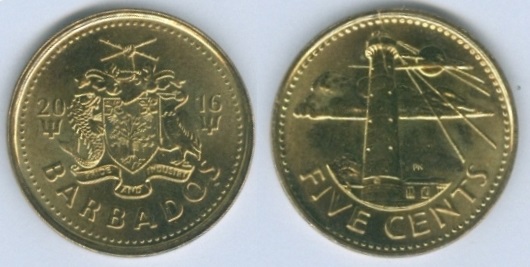 |
Same as above
KM#11a, 5 cents, but...
Year: 2016.
Weight: 3.48 g
[3.50g]. Mint:
Royal Canadian Mint.
Mintage:
N/A.
Type2:
Light type and magnetic. |
|
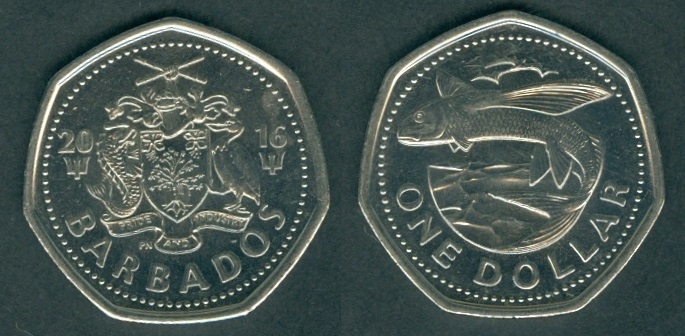 |
Same as above
KM#14.2b, 1 Dollar, but...
Year: 2016.
Weight: 5.56 g
[5.50g]. Mint:
Royal Canadian Mint.
Mintage:
N/A.
Type4:
Small and light type; magnetic. Weight reduced from 5.95 to 5.50
grams. |
|
| |
| |
| |
|
 |
| |
- Leader of Government
Business
- Grantley Herbert
Adams....................................1946 - 01 Feb 1954 d. 1971
- Premiers
- Grantley Herbert
Adams (continued).................01
Feb 1954 - 17 Apr 1958
- From 23 Jul 1957, he became known as Sir
Grantley Herbert Adams.
- Hugh Gordon
Hylvestra Cummins......................17 Apr 1958 - 08 Dec 1961 d. 1970
- Errol Walton
Barrow................................08 Dec 1961 - 18 Nov 1966 d. 1987
- Prime
ministers
- Errol Walton
Barrow (continued
- 1st time).........18
Nov 1966 - 08 Sep 1976
- John Michael
Geoffrey "Tom" Adams..................08 Sep 1976 - 11 Mar 1985 d. 1985
- Harold Bernard St.
John............................11 Mar 1985 - 29 May 1986 d. 2004
- Errol Walton
Barrow (2nd
time).....................29
May 1986 - 01 Jun 1987
- Lloyd Erskine
Sandiford............................01 Jun 1987 - 07 Sep 1994
- Owen Seymour
Arthur................................07 Sep 1994 - 16 Jan 2008 d. 2020
- David John Howard
Thompson.........................16 Jan 2008 - 23 Oct 2010 d. 2010
- Freundel Jerome
Stuart.............................23 Oct 2010 - 25 May 2018
- Mia Amor Mottley (female)..........................25
May 2018 - date
|
| |
|
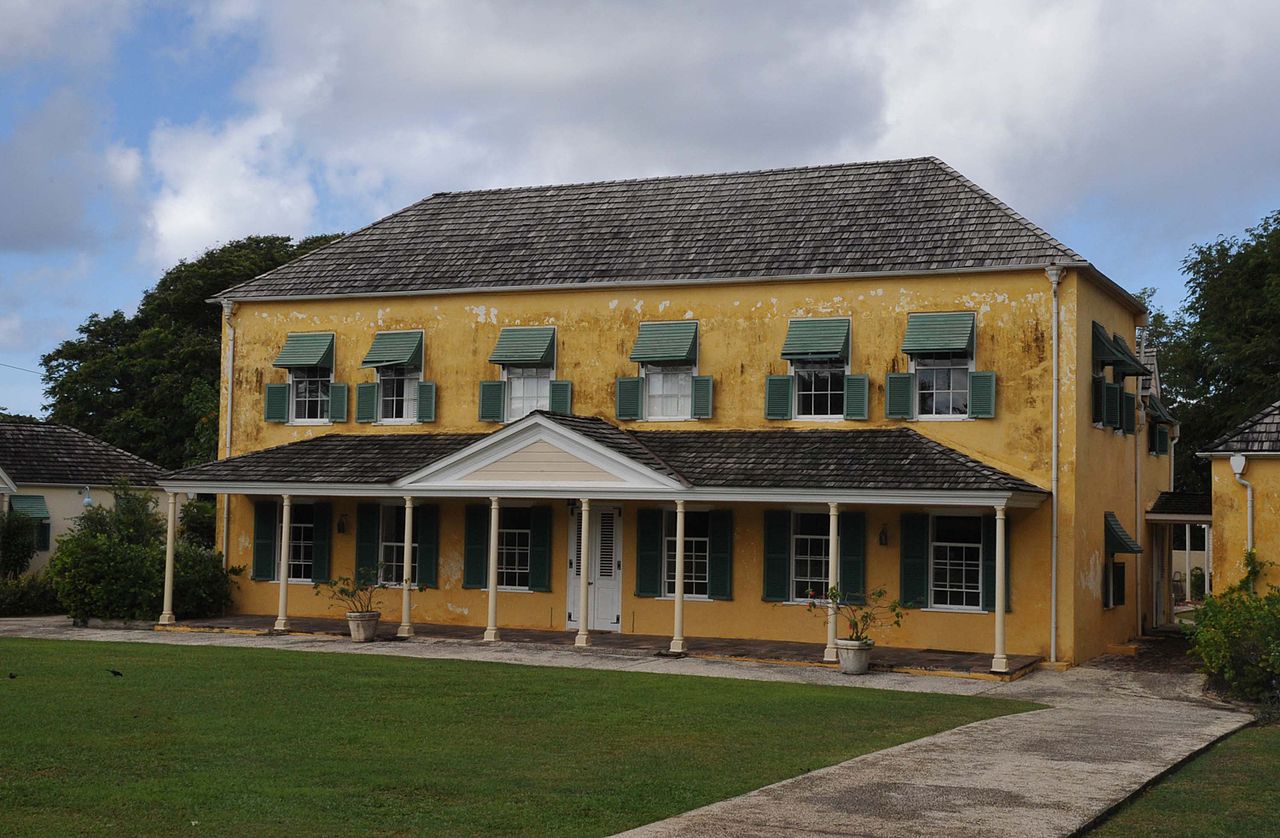 |
| |
George Washington House in Barbados
is a historic house where the future first U.S. President George Washington
visited, in 1751. He was 19 years old at the time and traveling with his
ailing half-brother, Lawrence Washington. In 2011, the property was
designated as a UNESCO protected property within the World Heritage Site of
Historic Bridgetown and its Garrison area. The house is owned and maintained
by the Barbados National Trust. Coordinates: 13°04′55″N 59°36′24″W.
Barbados apparently is the only country outside the present United States
that George Washington ever visited. |
| |
| |
| |
|
|
| Countries
/ Territories |
| |
|
Chiefa Coin | |
|
























































































